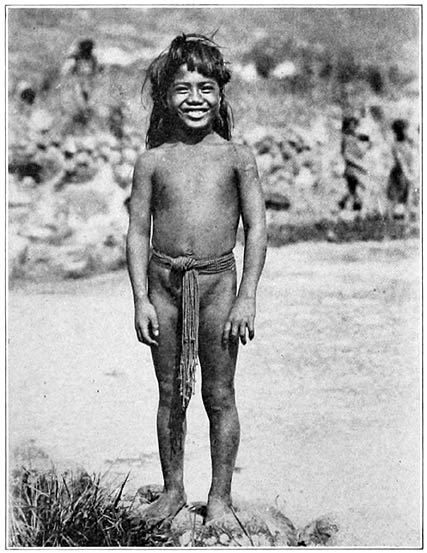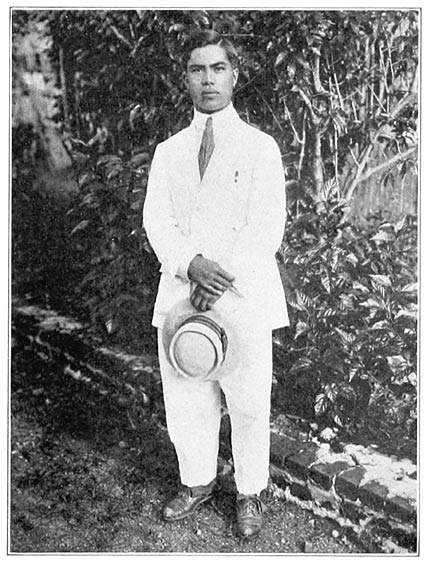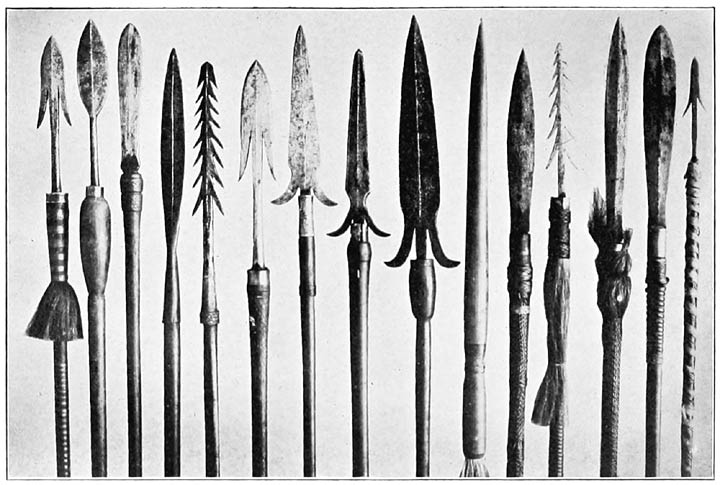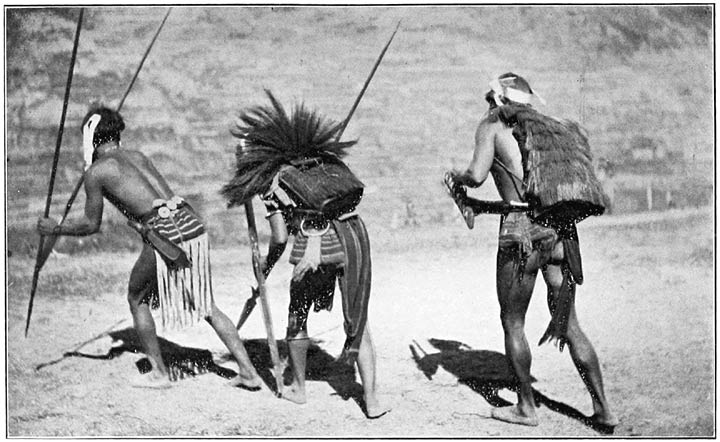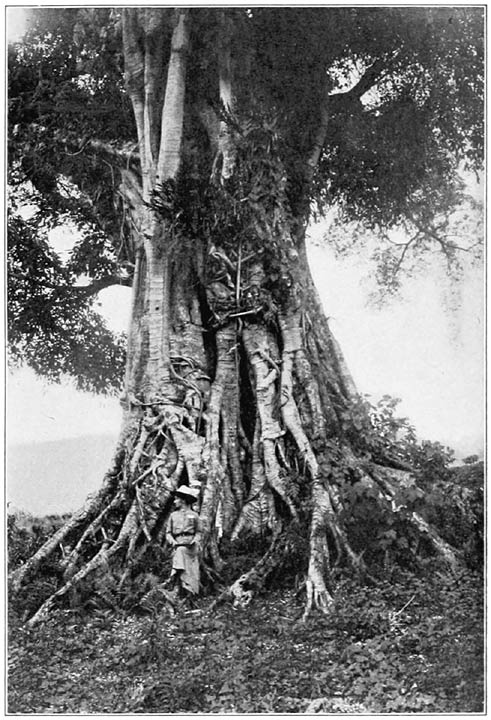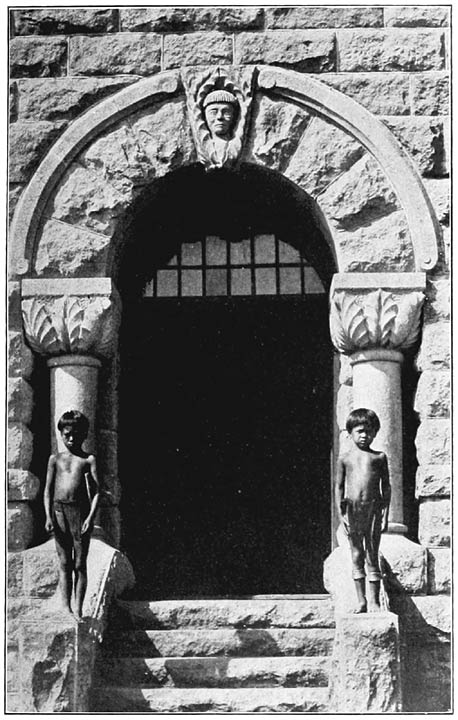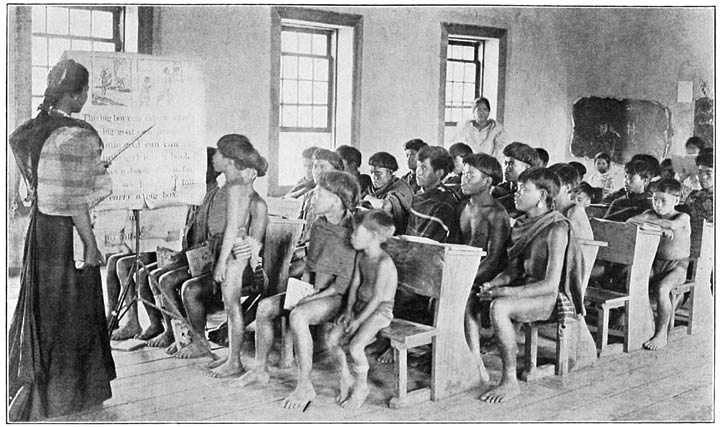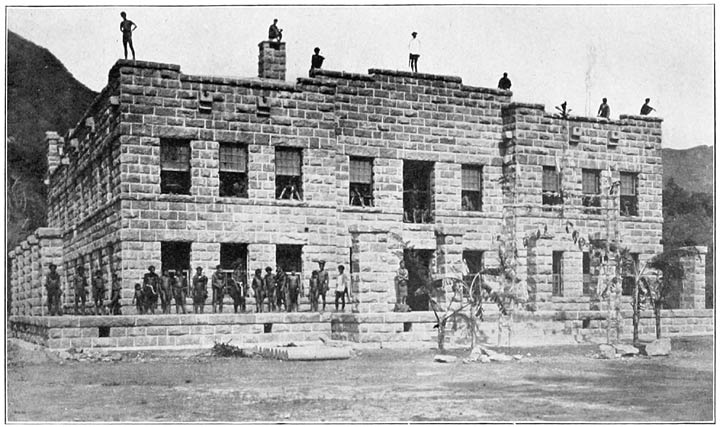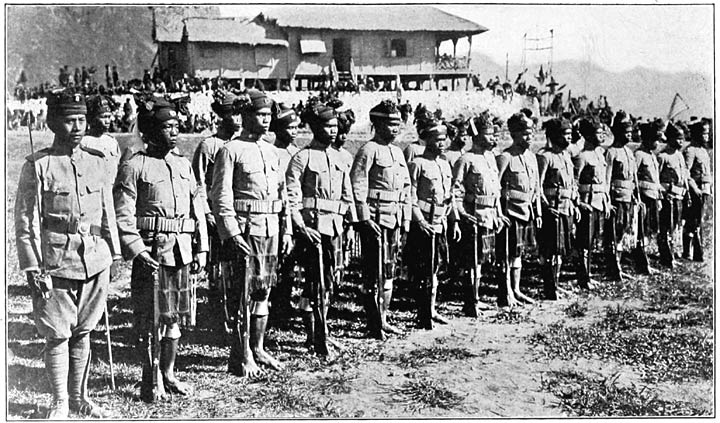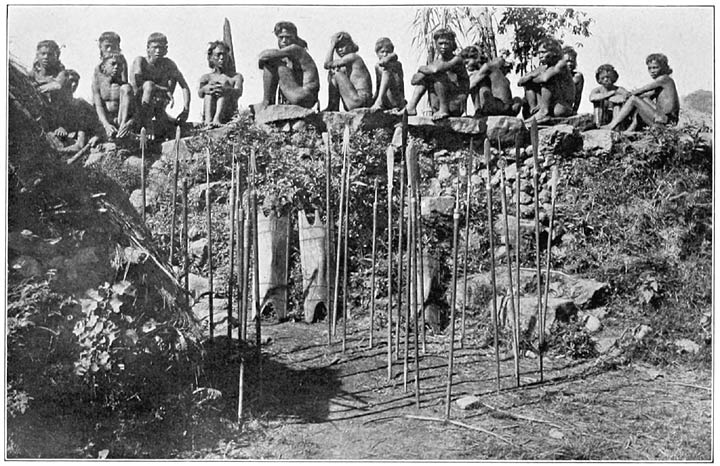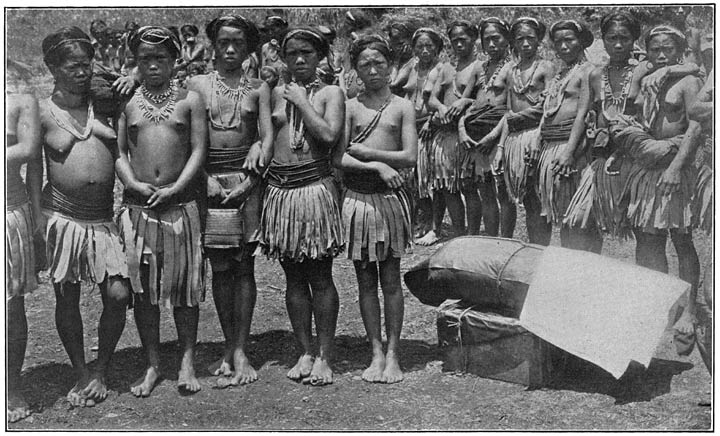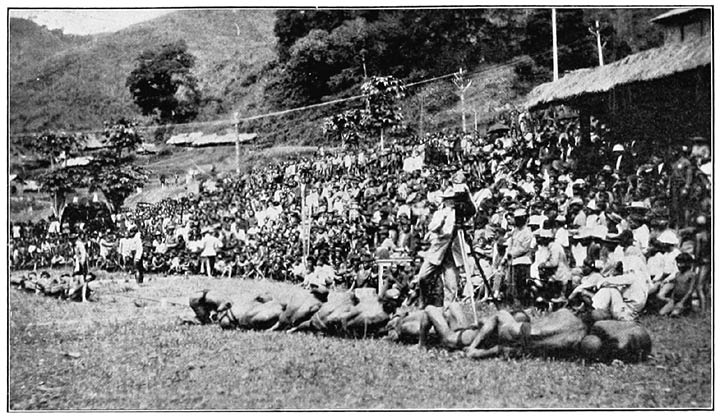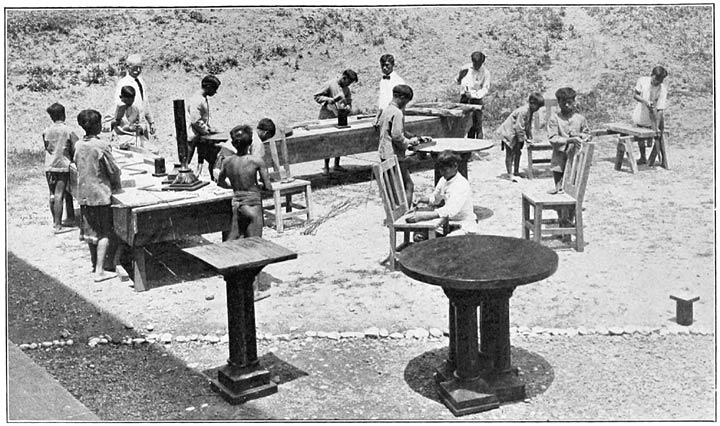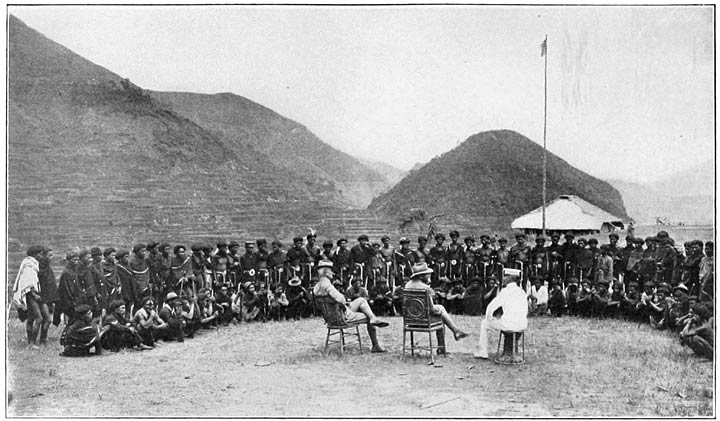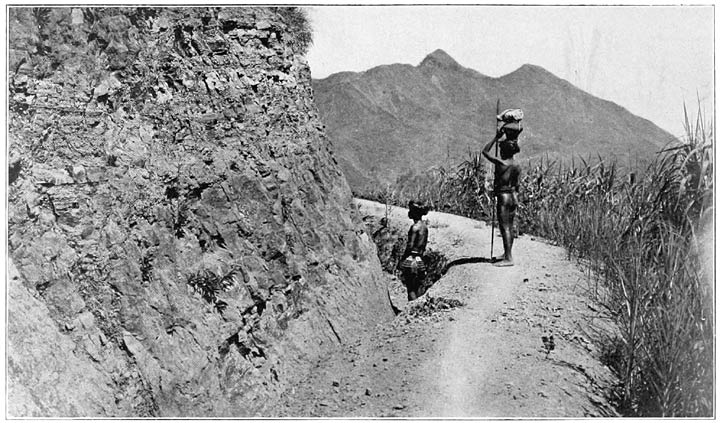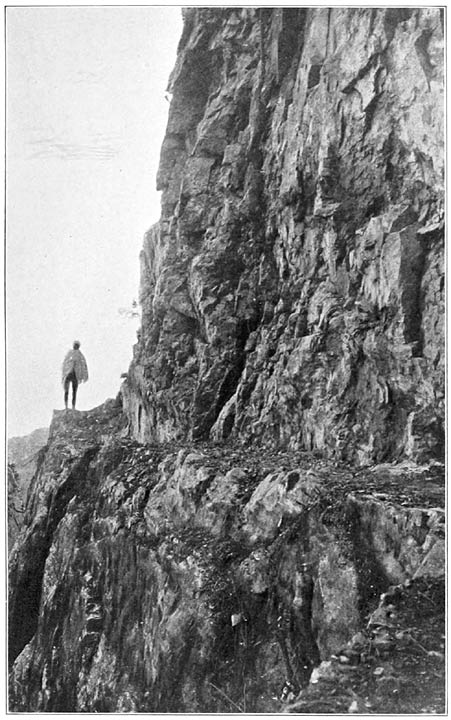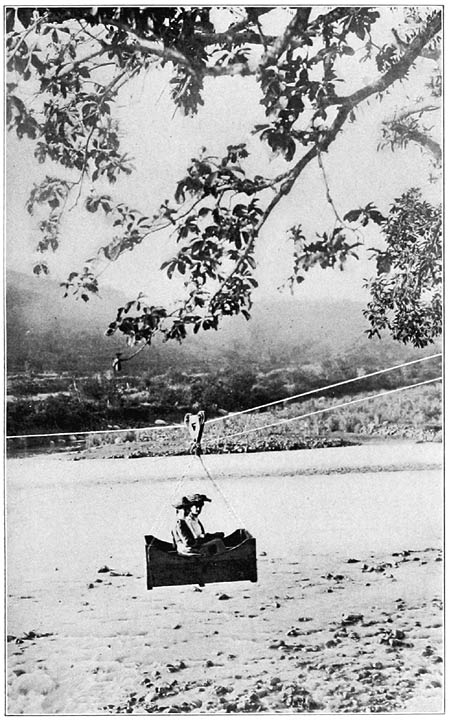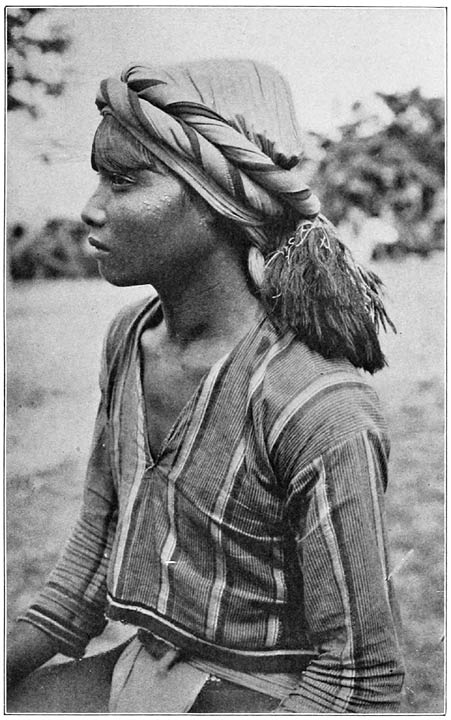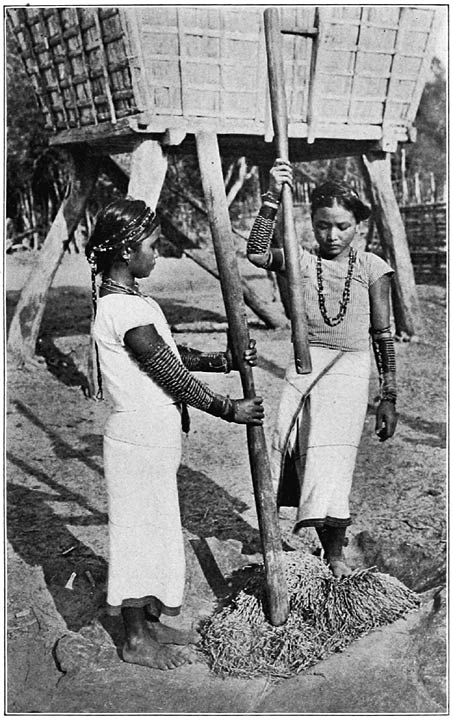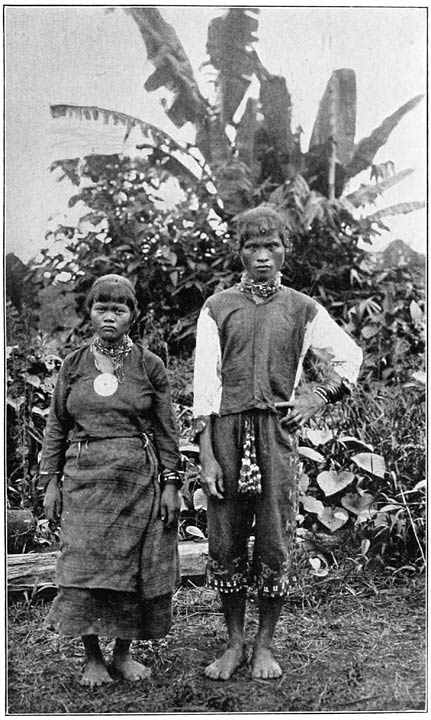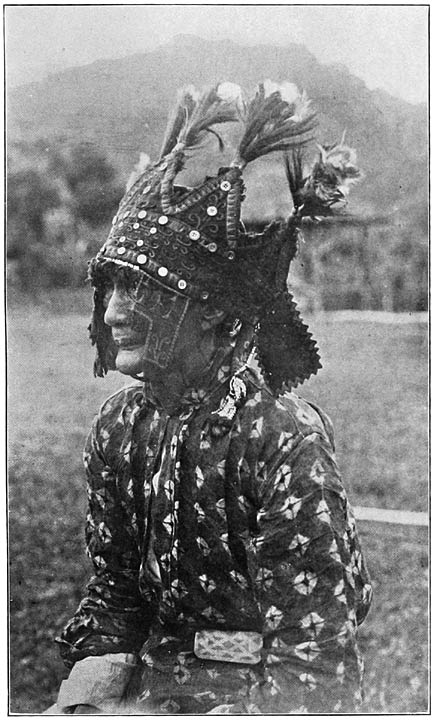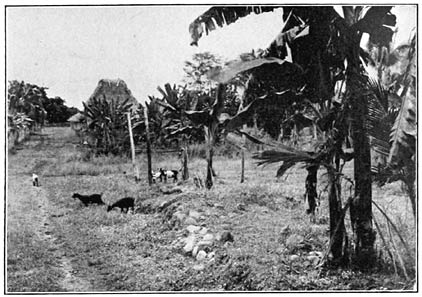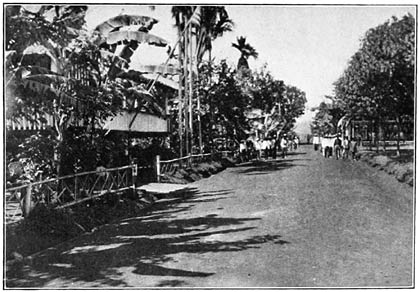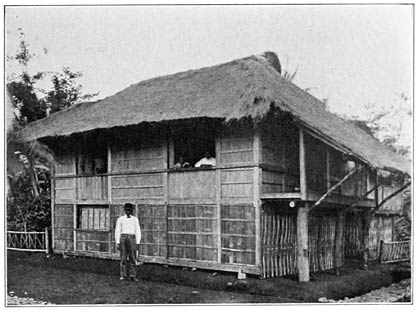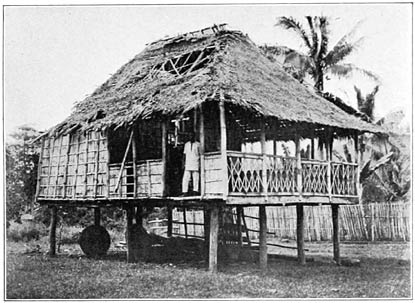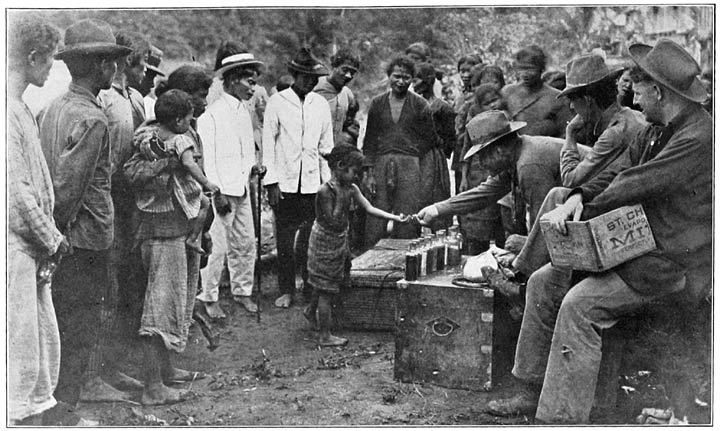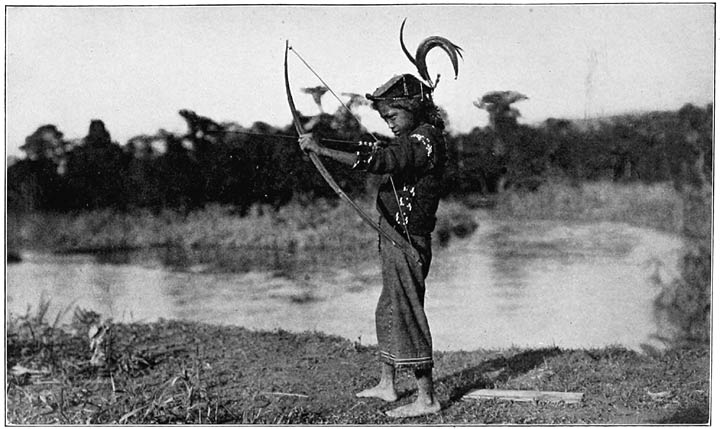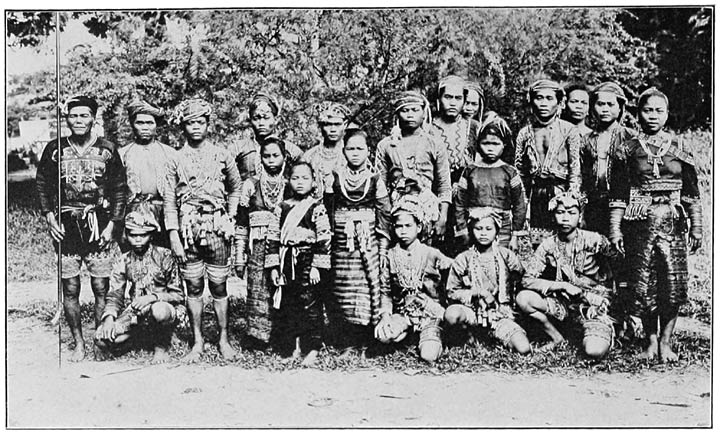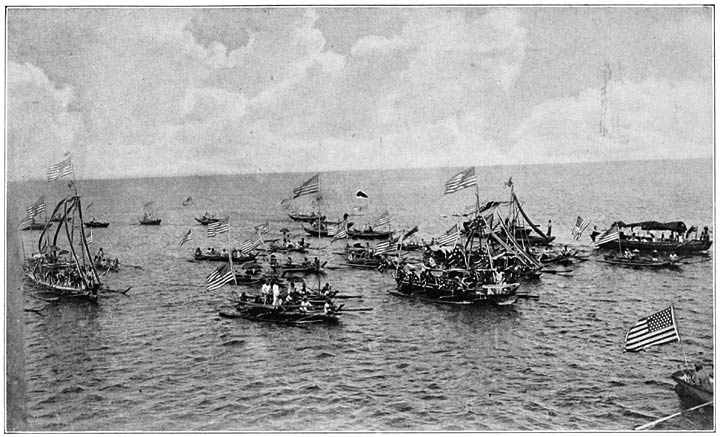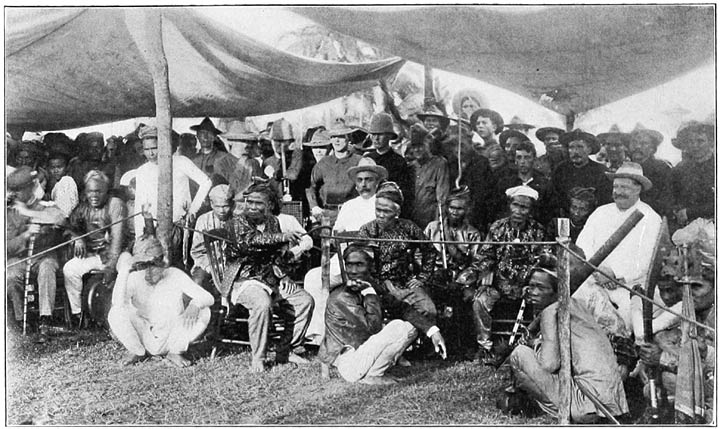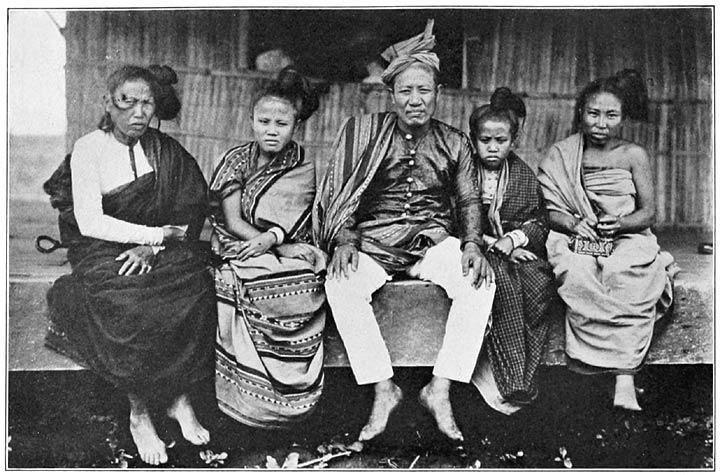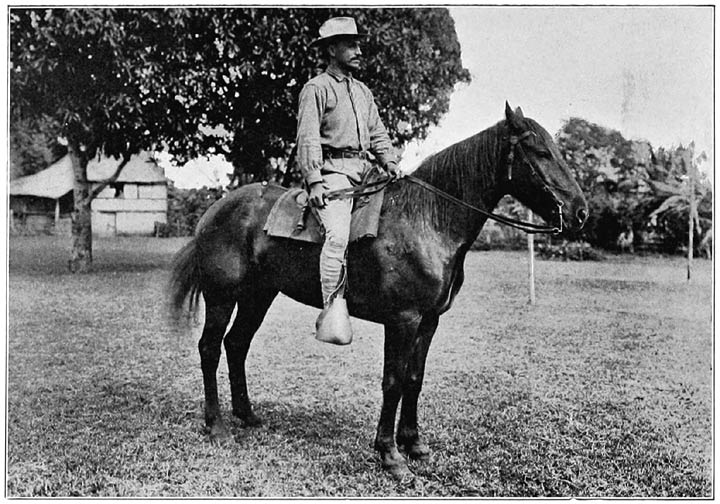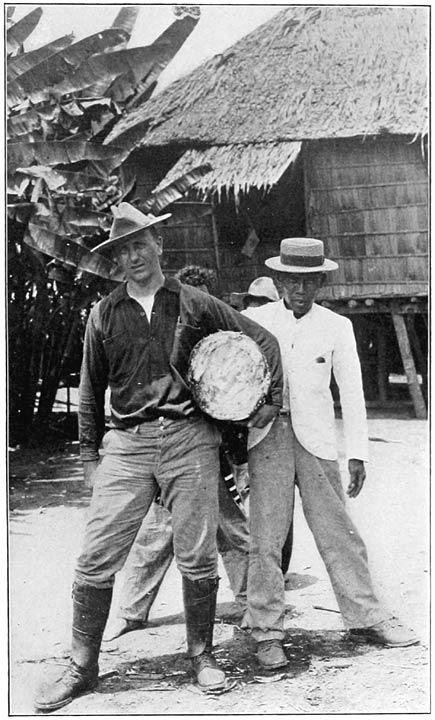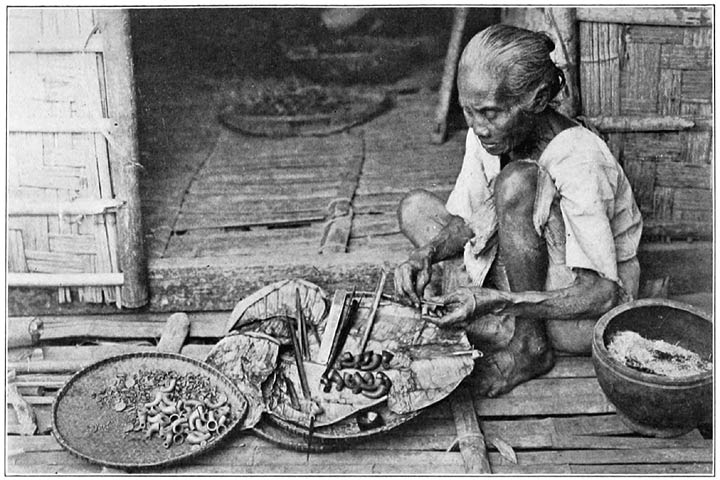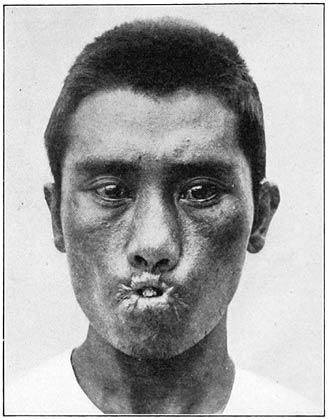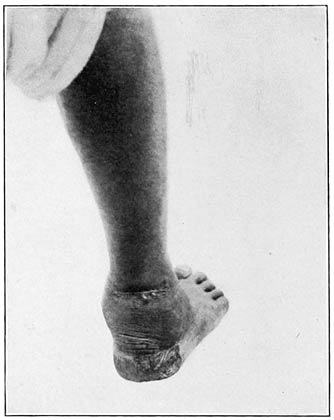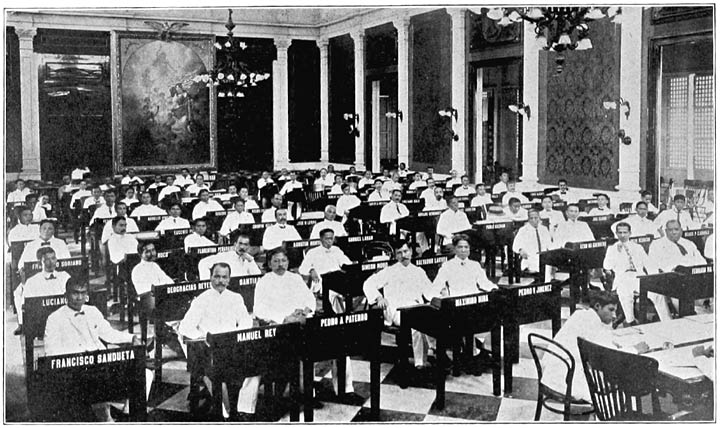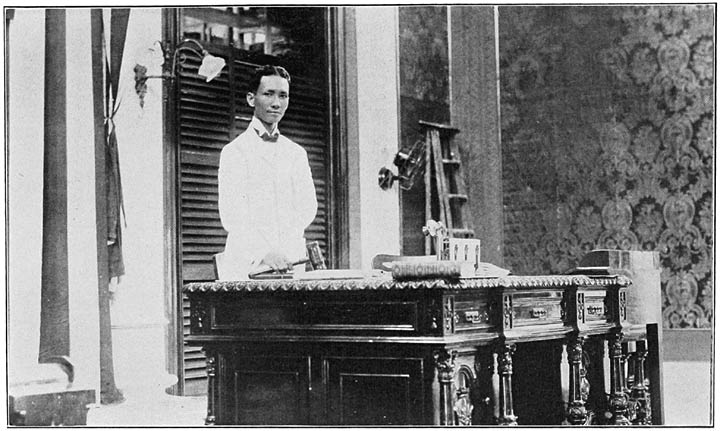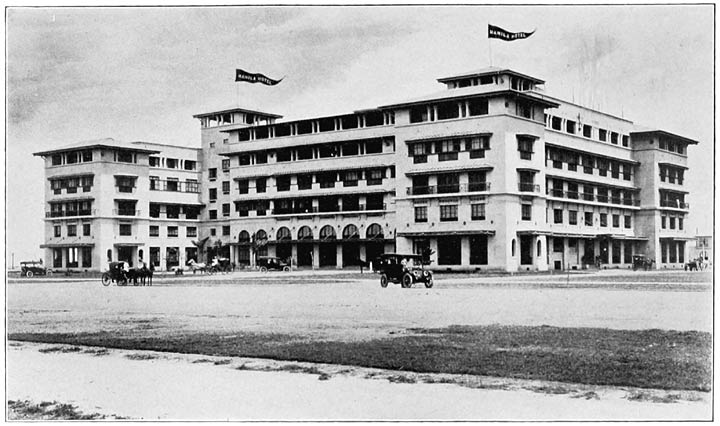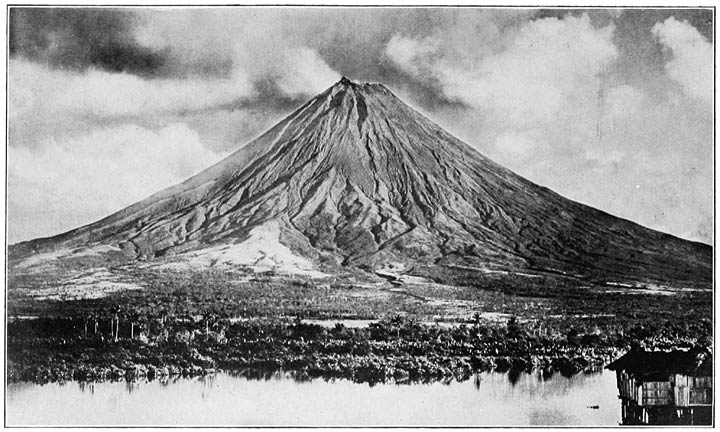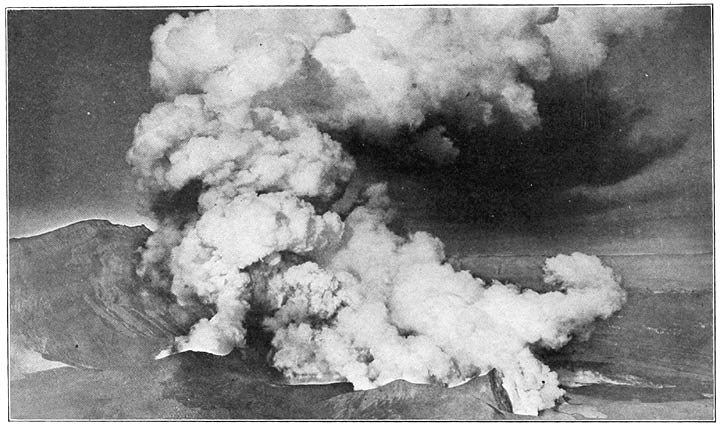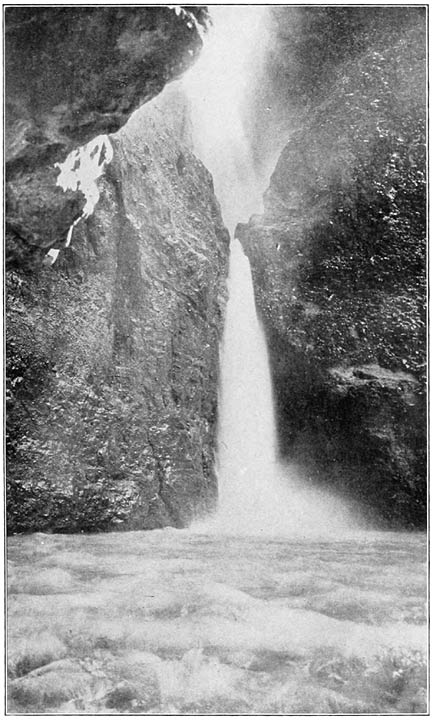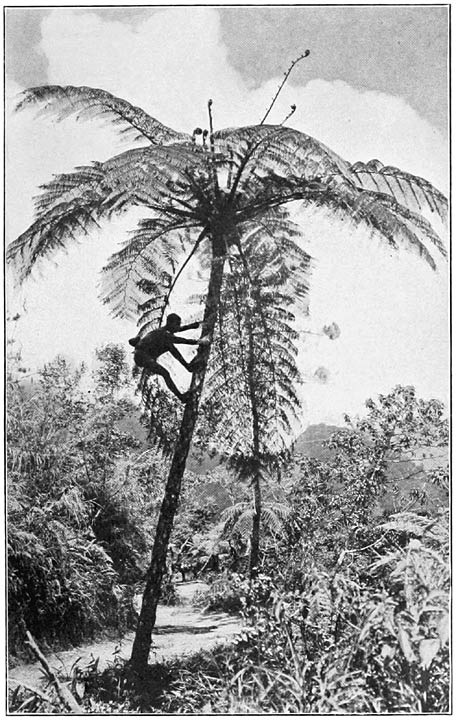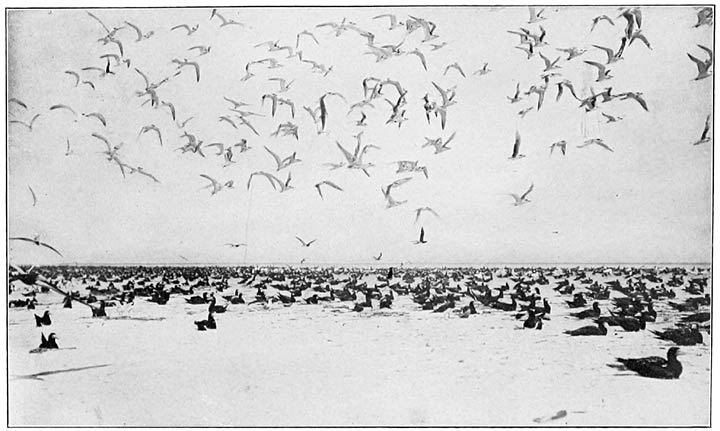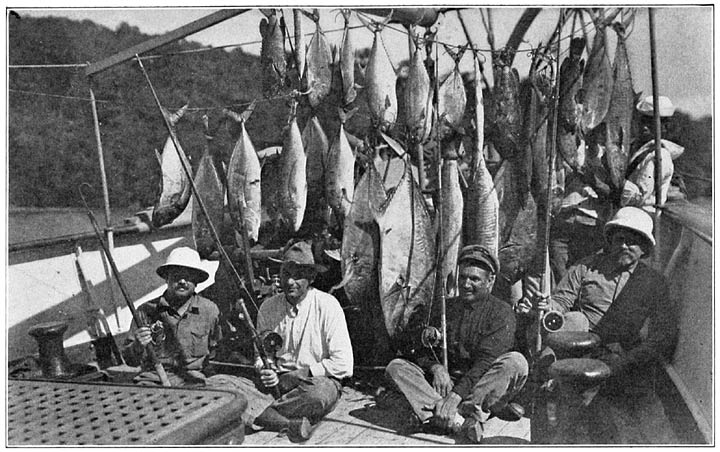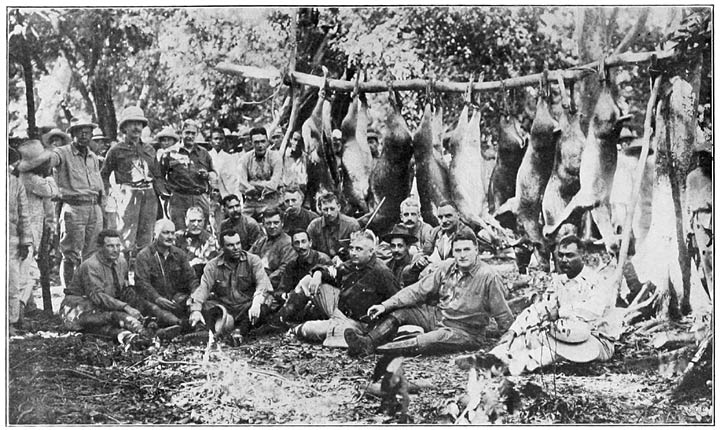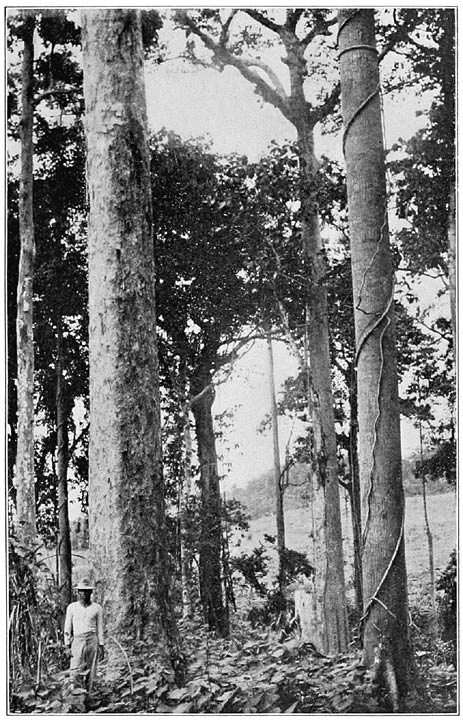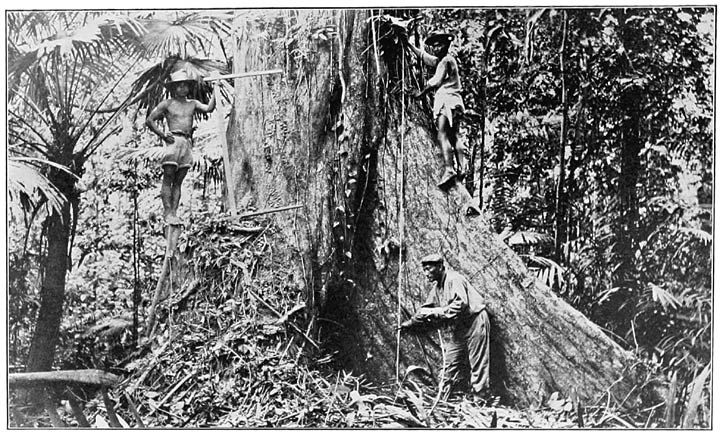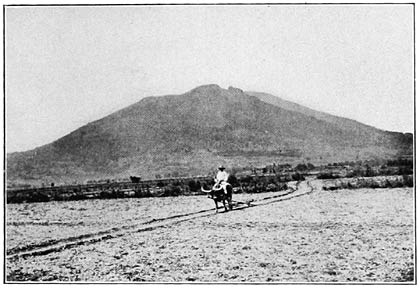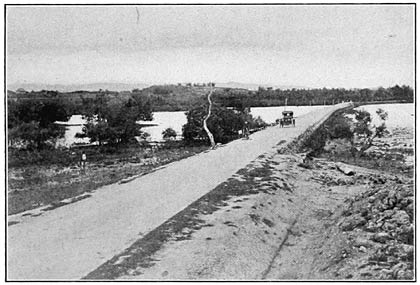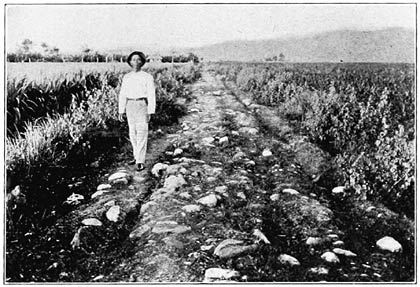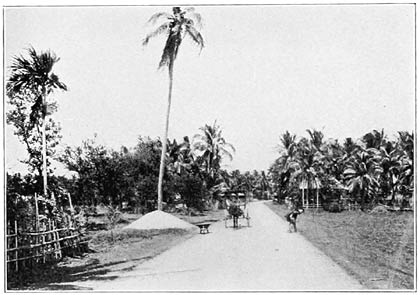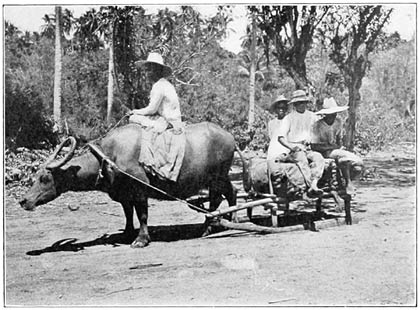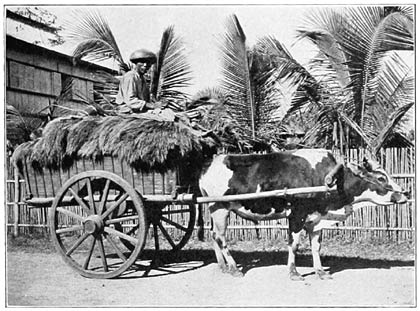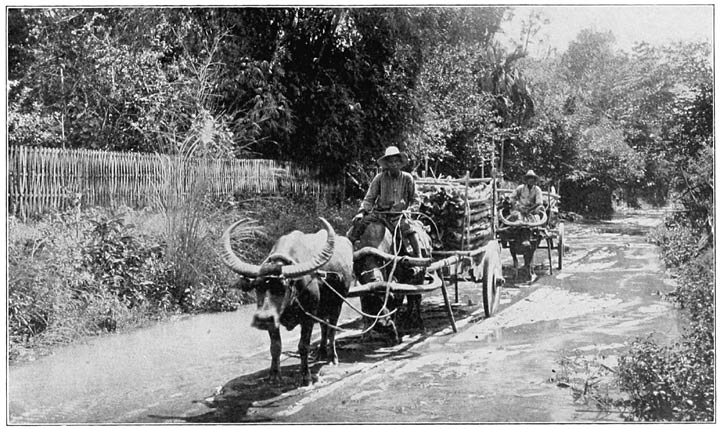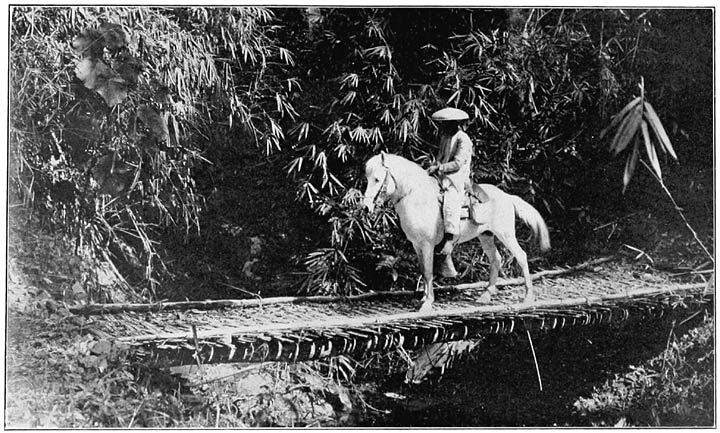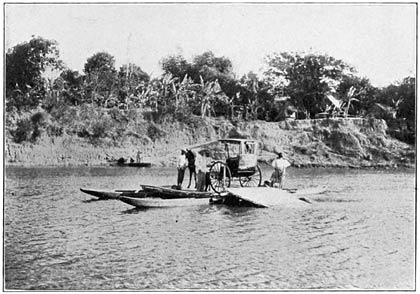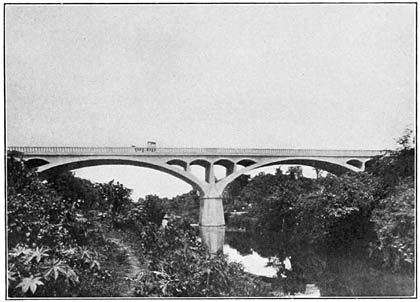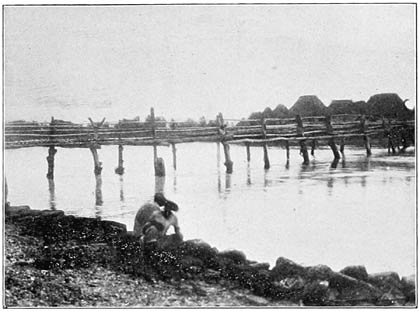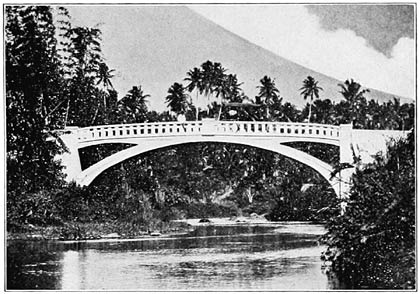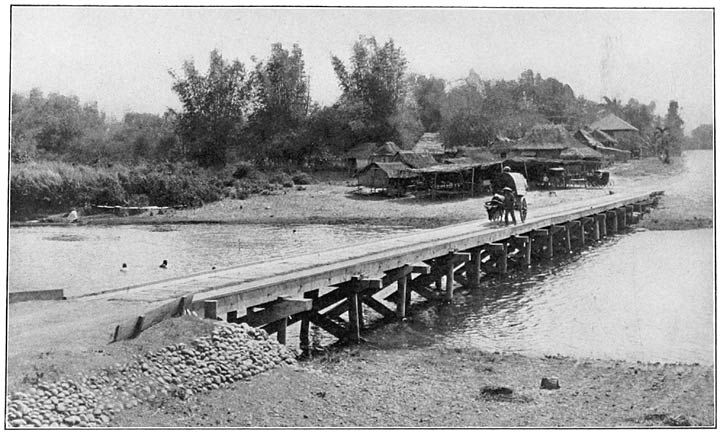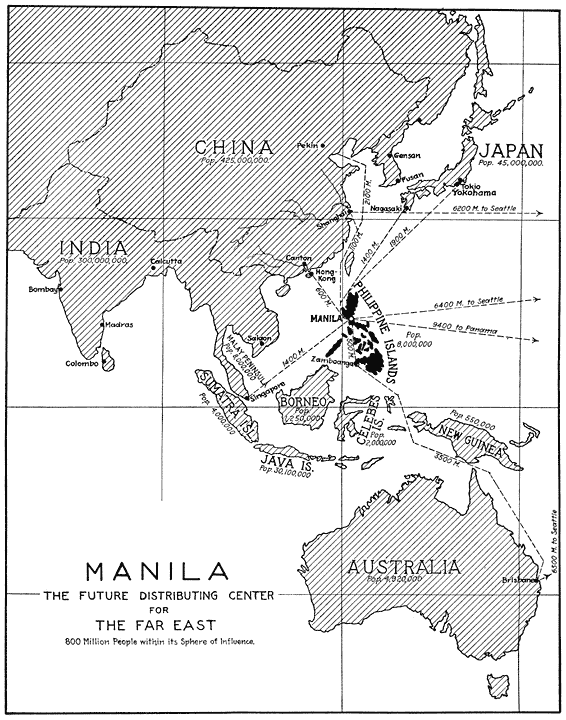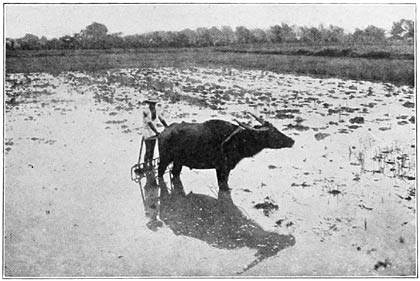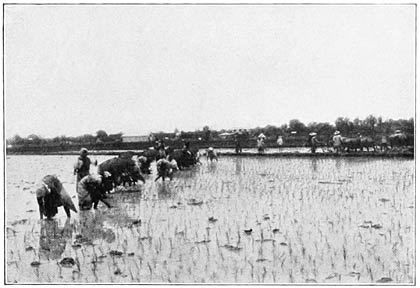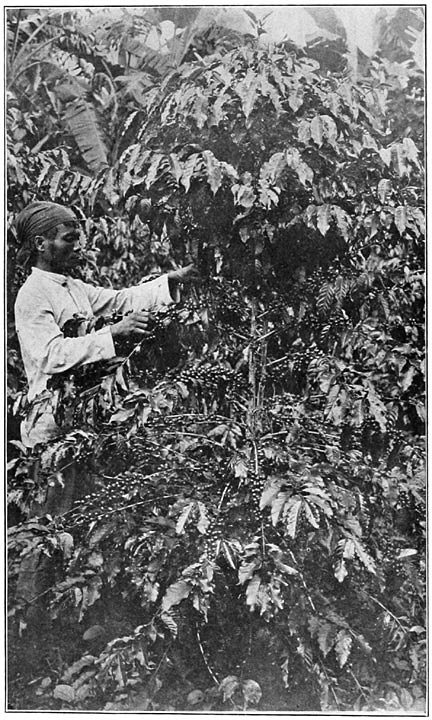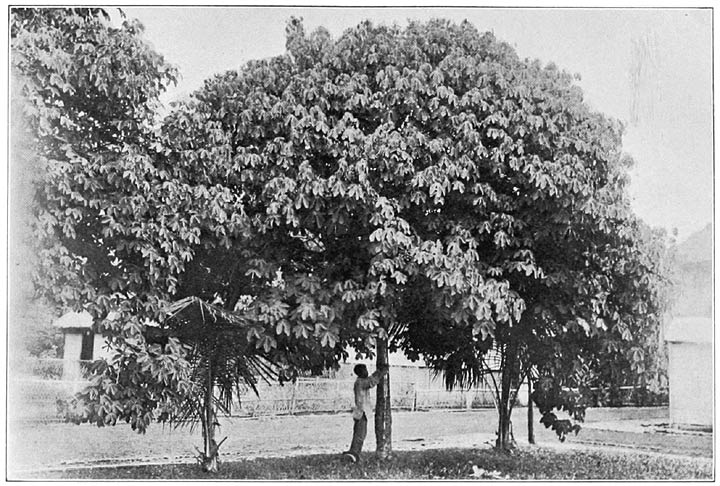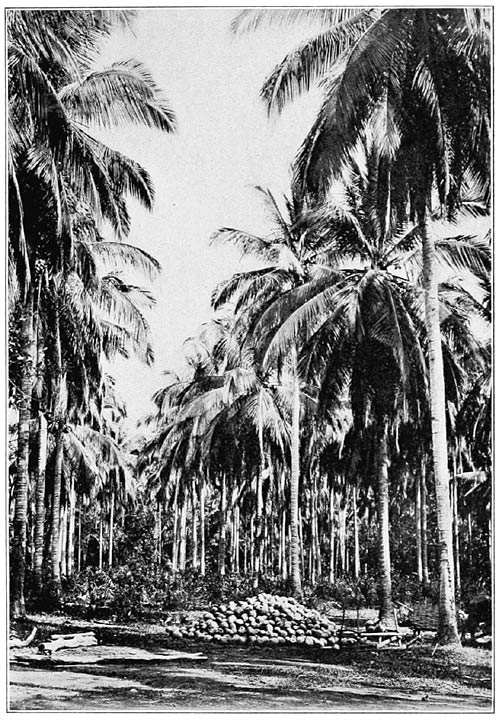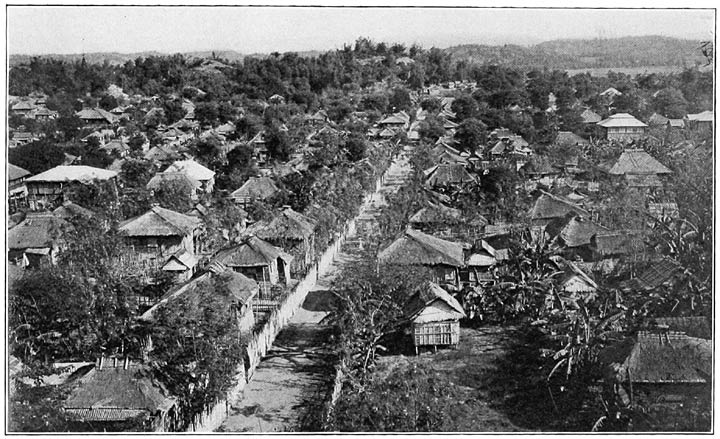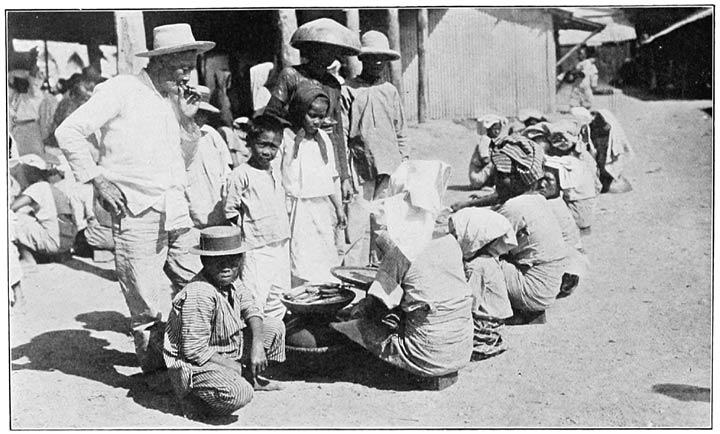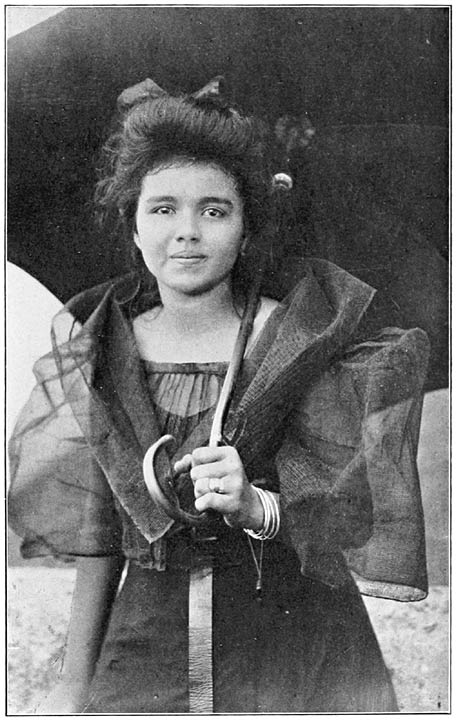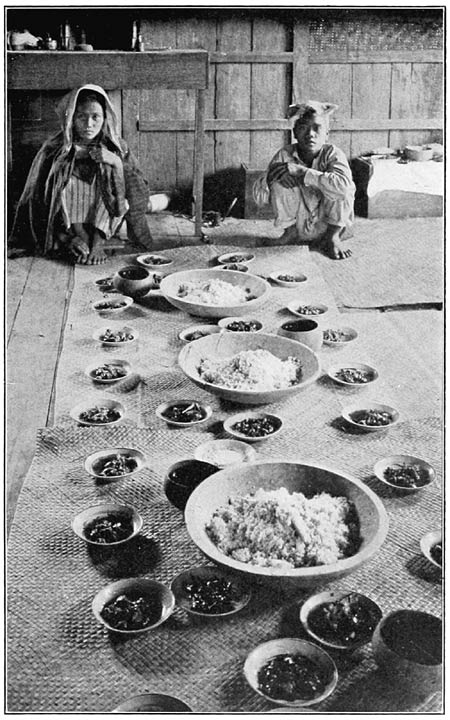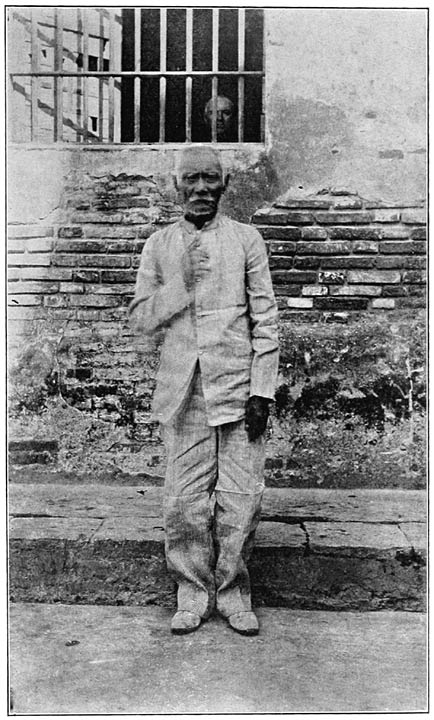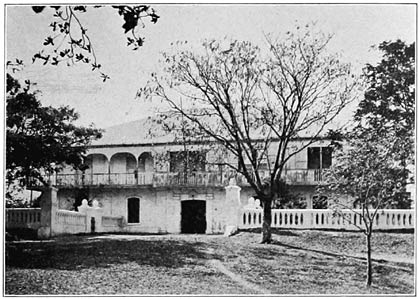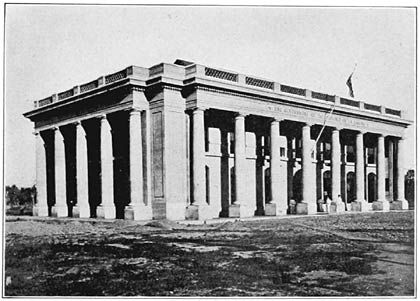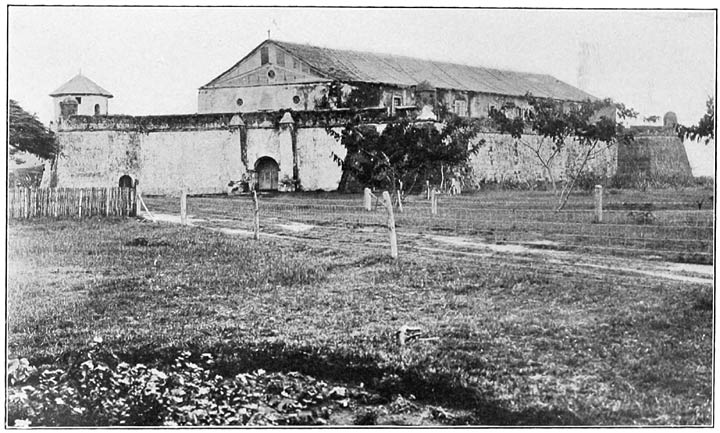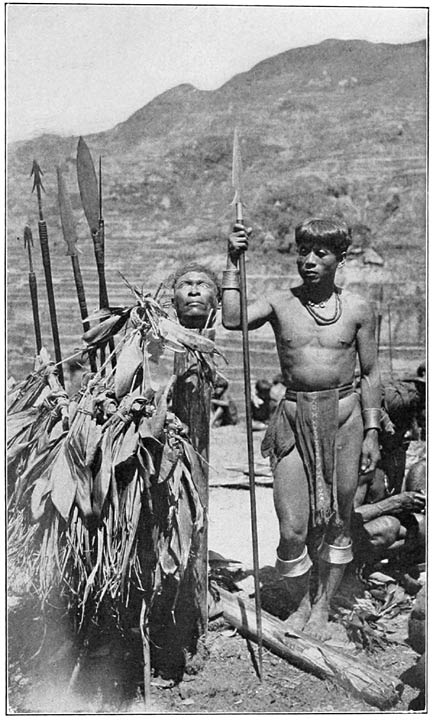Chattel slavery existed in the Philippine Islands when
Magellan discovered them in 1521. It exists there to-day.
Morga, who was in the Philippines from 1595 to about 1608, and is
admittedly the most reliable chronicler of the events of those early
days, has given the following interesting account of the conditions
then existing:1—
“There are three classes of persons among the
natives of these Islands, by which the commonwealth is divided:
principales, of whom I have spoken before;
timawa which is the same as plebeians, and slaves, of principales as well as of timawa. These slaves were of
various classes: some are in entire servitude and slavery, like those
which we have, and these are called sagigilir; they served in
the interior of the houses and so also the children descended from
them; others, who have their own dwellings, which they inhabit with
their family, away from the house of their master, and these come in at
times to help the latter in their fields and crops, as also aboard the
vessel when they embark, and in the construction of their houses
whenever they erect such, and they also serve in their houses whenever
there is a guest of some distinction, and they are under obligation,
whenever the master has them called, to come to his house and to serve
him in this ministry without pay or other stipend; these are called
namamahai, and their children and descendents are slaves of the
same condition. Of these slaves sagigilir and namamahai
there are some who are slaves entirely, and others who are only half
slaves, and others who are slaves only for a fourth part. This
originates thus: if either the father or the mother was free and they
had a single child, the latter was half free and half slave. If they
had more than one child, the children were distributed in this way: the
first followed the condition of the [677]father, be he free or
a slave, and the second that of the mother; and if the number was
uneven, the last child was half free and half slave; and those
descended from such child, if they had a free father or a free mother,
remained slave only for a fourth part, because they were children of a
free father, or mother, and of a half slave. These half or quarter
slaves, namamahai or sagigilir, serve their masters only
every second month, respectively, in proportion to their condition as
slave.
“Among the natives the ordinary price of a slave
sagigilir used to be, if much, ten taes of good gold, worth 80
pesos, and if he is a namamahai half of that, and thus in
proportion the others, taking into account the personality and age.
“It cannot be established as a principle from where these
classes of servitude among the natives arose, for they are all of the
islands and not foreigners; it is understood that they made them in
their wars and differences; and the most certain is that those who were
most powerful made and took as slaves the others for slight causes and
occasions, and most often through loans and usurious contracts current
amongst them, the payment, risk and debt increasing with the lapse of
time until they became slaves; and thus all these forms of servitude
have their violent and unjust origin, and it is about them that there
arise the greater part of the lawsuits that exist among the natives and
with which they keep busy the judges in the forum of the court, and the
confessors in that of the conscience.”
To the last of the preceding paragraphs Rizal makes the following
annotation, which, mutatis mutandis, should give leading
Filipinos of to-day matter for reflection:—
“This class of slaves exists even now in many
parts, and before all in the province of Batangas, but it must be
confessed that their condition is very different from that of a slave
in Greece, or Rome, from that of the negro, and even of those made in
later times by Spaniards....
“Filipinas, in spite of so many centuries of christianization,
in spite of the efforts of some few noble minds, priests as well as
civilians, continues still, and is desired to continue, almost in the
same state as formerly, for those who direct the country look more to
the present than to the future, and because they are guided not by
confidence, but by fear. The efforts of the religious corporations to
improve this state of things have never been as efficacious, nor as
strenuous, as might have been expected from them.”
[678]
Morga continues:2—
“These slaves are the greatest wealth and
capital which the natives of these islands possess, because they are to
them very useful and necessary for their labors and farms; and among
them they are sold, exchanged, and made objects of contract, like any
other merchandise, from one pueblo to the other, from one province to
the other, and likewise from one island to the other. For which reason,
and in order to avoid so many lawsuits that would arise, if the
question of these servitudes, their origin and beginning, were taken
up, they [the slaves, Tr.] are retained and
kept as they were kept formerly.”
Rizal comments on this passage as follows:—
“Thus catholicism not only did not liberate the
poor class from the tyranny of the oppressive, but with its advent in
the Philippines increased the number of tyrants. Time alone, and
instruction, which with it brings suaver customs, will ultimately
redeem the Pariahs of the Philippines, for we see that the apostles of
the peace did not find in themselves sufficient valour to battle with
the oppressors, and this in times of great faith; on the contrary, they
rather contributed indirectly to their misery, as we see from the
foregoing.”
The most frequent cause, already mentioned above, from which these
conditions of servitude arose, is again pointed out by Morga in the
following passage:3—
“Loans with interest were in very common
practice, excessively high rates of interest being current, so that the
debt doubled and multiplied all the time during which the payment was
deferred, until there was taken from the debtor what he possessed as
capital, and, when ultimately nothing more was left, his person and his
children.”
Of these statements Rizal says:—
“This is the sad truth, and so much the truth
that it subsists until now. In many provinces, and in many towns, there
is taking place, word for word, what Morga says, it being to be
lamented that at present not only Indios
[Filipinos, Tr.] continue this usury, but also
the mestizos, the Spaniards, and even various priests.
And it has come to this that the Government [679]itself not only permits it, but in its turn
exacts the capital and the person in payment of the debt of others, as
occurs with the cabeza de barangay.”
It would be easy to compile passages similar to the preceding from
other authors, but those given are explicit and authoritative enough to
make it clear, first, that slavery existed in the Philippines at the
time of the conquest as a general tribal institution of social and
economical character and in minutely regulated form; and, second, that
although it lost, with the advent of the Spaniards, the character of an
institution, and indeed was formally abolished by early edicts from
Spain, it continued to exist as an unauthorized practice, so that
Rizal, writing at the close of the nineteenth century could say that
slaves still existed in many parts of the country.
In a statement recently published in the New York Evening
Post, Señor Quezon, Resident Delegate from the Philippines
to Congress, has said:—
“Since there is not, and there never was,
slavery in the territory inhabited by the Christian Filipinos, which is
the part of the Islands subject to the legislative control of the
Assembly, this House has refused to concur in the anti-slavery bill
passed by the Philippine Commission.”
Whom will the American public believe, Morga, the historian, and
Rizal, the Filipino patriot, or Quezon, the Filipino politician?
While I entertain no doubt as to the answer, I shall nevertheless
discuss at length the more recent history and present status of slavery
and peonage in the Philippines, because of the vital importance of full
knowledge of the facts to intelligent consideration of the claim that
the Filipinos have arrived at a stage of civilization comparable with
that of the more advanced nations of the world, and are capable of
establishing and maintaining a just and humane government. [680]
The Spanish Penal Code did not prohibit or penalize slavery, or the
purchase or sale of human beings. It did contain provisions against
forcible detention of individuals and the abduction of minors, but in
the Philippines at least they were more honoured in the breach than in
the observance during the Spanish régime.
The Moros raided the towns of the peaceful Filipino inhabitants of
the Visayan Islands and of Luzón until within quite recent
times. An unhappy fate awaited the prisoners whom they took. Men were
frequently compelled to harvest for their captors the crops which they
themselves had planted, and were then mercilessly butchered. Women,
girls and boys were carried away into slavery, the former to serve as
household drudges or as concubines, and the latter to be brought up as
slaves pure and simple. Some men met a similar fate. The only reason
that more were not enslaved was that it was usually considered too much
trouble to make full-grown individuals work. Slaves were held as
chattels if it suited the convenience of their masters to retain them,
and otherwise were sold, bartered or given away. Zamboanga was at the
outset largely populated by escaped Moro slaves who had sought the
protection of the Spanish garrison there. Coming originally from widely
separated parts of the archipelago, these unfortunates had no common
native dialect, hence there arose among them a Spanish patois now known
as Zamboangueño.
The American occupation brought many and brusque changes in
political conditions. The attitude of Americans toward slavery and
peonage was very different from that of the easy-going Spaniards, who
had never sanctioned it but had never made any determined effort to
break it up.
From the effective establishment of United States sovereignty in
1899 until July 4, 1901, the Philippines were under military rule,
which has one great advantage: its methods usually bring quick results.
[681]
Doubtless the majority of the slaves then held in the islands were
too timid, and too suspicious of the character and purposes of
Americans, to appeal to them for protection; but there were not a few
whose lives had become so unbearable that they were prepared to take
almost any risk on the chance of securing release. People of this class
ran away from their masters and sought the protection of army officers.
I am glad to say that in every such instance which has come to my
knowledge it was promptly given. Not only were they advised that they
could not be held in bondage, and were free to go where they pleased,
but when practicable their masters were warned against attempting to
regain control over them. It is probable that the large majority of
such cases were never officially reported. Most of the army officers
concerned were in some doubt as to their legal status in the premises,
but they knew that the constitution of the United States prohibits
slavery; their sympathies went out to the wretched human beings who
appealed to them for aid, and they decided to be a law unto
themselves.
After the establishment of civil government some army officers
continued to exercise arbitrary powers in dealing with such cases of
slavery as came to their attention, while others contented themselves
with reporting them to the civil authorities.
The conditions which prevailed in the Moro Province in 1902 are
concisely described by its military governor, General George W. Davis,
in a report written on August 25 of that year. He said:—
“With a people who have no conception of
government that is not arbitrary and absolute; who hold human life as
no more sacred than the life of an animal; who have become accustomed
to acts of violence; who are constrained by fear from continuing the
practice of piracy; who still carry on slave trade; who habitually raid
the homes of mountain natives and enslave them; who habitually make
slaves of their captives in war—even when of their own race; who
not uncommonly make delivery of their own kindred as slaves in
satisfaction of a debt [682]for liquidation of which they have
not the ready money; who habitually observe the precepts of the Koran,
which declares that female slaves must submit to their
masters,—it is useless to discuss a plan of government that is
not based on physical force, might, and power.”
Señor Quezon, in describing conditions in the Moro country,
has said:4—
“American authorities made treaties with the
Sultan of Joló whereby slavery was legalized and recognized
among the non-Christian Moros and received the protection of the United
States army and civil authorities. This state of things continued for a
long time under official recognition and even after the treaties in
question were abandoned it was allowed to go on despite the protests of
Filipino and American students of the question.”
It is true that General Bates attempted to negotiate a treaty with
the Sultan of Joló, in which he felt himself compelled to
recognize slavery as an existing Moro custom. This action was
unauthorized and was disapproved by his superiors. It did not legalize
slavery. Neither Moro nor any other kind of slavery was ever protected
by the civil authorities.
The act providing for the organization of the Moro Province was
passed on June 1, 1903, and hardly had the civil officers therein
provided for been appointed when, on September 24, 1903, the
legislative council passed an act entitled “An Act defining the
crimes of slaveholding and slavehunting and prescribing the punishment
therefor,”5 which was promptly approved by the Philippine
Commission and thus came to have the force and effect of law. Under it
active measures were adopted to [683]break up slavery in the Moro
Province. They have resulted very successfully, and persons who have
captured others to be held or sold as slaves, as well as persons who
have actually sold, bought or kept slaves, have been convicted and
punished.
Señor Quezon’s statement relative to the attitude of
the civil authorities in this matter is therefore recklessly false.
The existence of slavery in the Moro Province was well known from
the outset, hence the immediate enactment of legislation to meet the
special conditions which prevailed there.
Little by little the commission learned that slavery was by no means
confined to Moro territory, and that peonage was general throughout the
islands.
Before going further, I wish to make clear the sense in which I use
these terms.
I define slavery as the condition of a human being held as a chattel
and compelled to render service for which he is not compensated. As
food and clothing are necessarily furnished by the slave owner, they
are not considered to constitute compensation.
Peonage I define as the condition of a debtor held by his creditor
in a form of qualified servitude to work out a debt.
On April 28, 1903, the senior inspector of constabulary in Isabela
wired the first district chief of constabulary, Manila, as
follows:—
“In this province a common practice to own
slaves. These are bought by proprietarios [property
owners.—D. C. W.] from Igorrotes and Calingas who steal same in
distant places from other tribes. Young boys and girls are bought at
about 100 pesos, men 30 years old and old women cheaper. When bought,
are generally christened and put to work on ranch or in house, and I
think generally well-treated. In this town a number sold within last
few months, and as reported to me, Governor has bought three. Shall I
investigate further? Instructions desired.
(Signed) “Sorenson.”
[684]
Senior Inspector Sorenson was instructed to make a thorough
investigation of, and a detailed report on, the slave question.
On May 2 he complied with these instructions,6 describing
the conditions under which slaves were taken by the neighbouring
Kalingas and Ifugaos, whom he wrongly calls “Igorrotes,”
the methods employed in selling them, and the treatment subsequently
given them by their purchasers.
He also furnished a list of “Igorrotes” sold in the
province during the past year, with names of the purchasers and prices
paid. The ages of these unhappy individuals varied from eight to
twenty-seven years, the prices paid for them, from one hundred and ten
to two hundred and fifty Mexican dollars.
This report led Governor Taft to write to Governor Dichoso of
Isabela, who was charged with owning a slave, asking him for a frank
statement of the facts as to the prevalence of slavery in his
province.
Governor Dichoso’s reply, dated September 9, 1903, will make
interesting reading for those who claim that slavery does not exist,
and has never existed, among the Filipinos. I give it practically in
full, omitting only the titles of the governor:—
“Having noted the contents of the official
letter of the Honourable the Civil Governor in the Philippine Islands,
Mr. W. H. Taft, dated the 8th of August, last, and of the copy of the
report annexed thereto, which were received yesterday, I have the
honour to respectfully reply that during the 21 years, more or less,
that I have resided in this provincial capital (Ilagan), I have never
thought of buying a member or a child of the race mentioned in the
report, or of any other tribe, to serve as a slave in my household, not
for the reason that this is prohibited and punished by section 484 and
the following sections of the Spanish Code now in force, relative to
the crime of kidnapping, but because it goes against my nature to treat
in this [685]manner a person who, like all human beings
alive, is a likeness of the Highest. This I prove by means of the
documents annexed hereto.
“I could easily have done so in time of the late Spanish
Government, because I had good opportunities for doing so, and could
have afforded to do so on account of my social position from that time
on up to date, during which period I held successively the following
public offices:—
* * *
“This having been my status, and considering the power and the
opportunity which I had for obtaining slaves, I might not have had only
one, but enough to harvest the tobacco on my plantation, and the other
crops which I had planted.
“Under the past Government there existed slaves in this
province, but only a small number, for only wealthy families could
afford to keep them. The same was the case in the neighbouring
Provinces of Nueva Vizcaya and Cagayan; in the former they
also used to have slaves of the Ifugao tribe, and in the latter
Negritos, but very few of these.
“Since the glorious Star-Spangled Banner has been unfolded
over the Province of Isabela, the slaves existing in the same, which
had been purchased in that time and recently, are very well treated and
seem to be members of the family, because the military authorities
prohibited their masters from ill-treating them as they were wont to
do. Since then many of the slaves have run away from their owners and
have sought new masters who treat them well, as it happened in the case
of an Igorrote woman of the Ifugao tribe, who was about 40 years of
age, and who had been in the service of a lady in the pueblo of Echague
for many years. When, in the year 1900, the military enforced the
prohibition of ill-treatment of slaves in the said pueblo, this
Igorrote woman ran away and presented herself at my house, I being at
this time justice of the peace of this provincial capital, and asked me
to employ her as servant. My principle not to have slaves preventing me
from complying with her wishes, I directed her to apply to Mr. Andres
Claraval and his wife, Filomena Salinas. They accepted her, and a short
time afterwards they had her baptized and christened Magdalena
Claraval. She is being treated like an adopted daughter by them.
“The gentlemen who are mentioned in the report as having
purchased slaves really acquired Igorrotes by purchase and keep them in
their house, some of them having died since. Some of these transactions
were made in the Spanish times, as in the case of the late Mr.
Policarpo Gangan, who bought 6 [686]or 7 Ifugaos, whom on his
death he left to his children, Mr. Pedro Gangan, Mrs. Susana Gangan,
Miss Maria Gangan, and Mrs. Rufina Gangan, and others were made
recently and secretly, while I was absent from town on official
business in the pueblos of this province. Mr. Thomas Gollayan, the late
provincial secretary, bought two Igorrotes while I was in Manila in
December and January, last. They were well aware of the fact that I
prosecuted kidnapping with tenacity, my object being to put a stop, if
possible, to this abominable practice, which has since some time
prevailed in the pueblos of this province....
“In order to prove that I endeavoured to make the proper
investigation for the purpose of proving whether slavery really existed
in this province, I have the honour to annex an affidavit by Agapito
Telan, a resident of Ilagan, in which it appears that he sold Igorrotes
of the Ifugao tribe to several residents of this town. I was unable to
ascertain the numbers of Igorrotes of the same tribe sold by Modesto
Sibal, Lorenzo Montevirgen, Lorenzo Montalvo, Andres Castro, and Cosme
Ferrer, who are engaged in the same business as Agapito Telan, as it
appears from the deposition of the latter, for the reason that these
persons did not appear before me, although in 1902 I had on several
occasions verbally requested the late municipal president, Mr. Pascual
Paguirigan, to cause them to appear in an unofficial manner. I was not
surprised that they did not appear before me, as Paguirigan was
involved in the investigation, as it happened in the case of the
aforesaid Agapito Telan, who appeared before me when I asked the acting
municipal president to have him do so.
“I was afraid to direct those persons to appear before me by
means of written orders, because I had not document or complaint
whereon to base them, as required by the procedure now in force, and
feared that on account of the unlawful nature of the summons they might
proceed against me for coaccion, and sue me besides for damages.
“According to my personal observation and to what I have seen
in the other pueblos of this Province of Isabela, but principally in
the provincial capital, the Igorrotes who are said to be slaves cannot
be considered as such since the times of the military government, as
they are considered and treated as members of the family of the chief
of the household. Nevertheless, I am and shall continue to be
inexorable in the prosecution of slavery, as it is a crime and should
be prosecuted as such, in order to prevent at least that the persons
engaged in this business commit this crime again. [687]
“It is my humble opinion that an act should be passed to the
end of eradicating this practice which has become general throughout
the Cagayan Valley.7 Otherwise, as I have seen in my
continual efforts, the provincial authorities cannot do anything to
check the evil, however they may try. It is necessary that some one
should be made to feel the rigour of the act suggested and suffer the
punishment designated by it.
“As a rule the inhabitants of this province already understand
personal liberty and know that a person is entitled to go wherever he
pleases, which liberty has given birth to the humane treatment of the
fellow-men which now prevails.
“Caciquism is still existing in parts of this province, but I
am confident that with the coöperation of sensible persons in my
continuous efforts it will be completely eradicated, and personal
liberty will reign supreme, as in every republic where the laws assure
complete and real liberty, the liberty from slavery.”
As supporting evidence Governor Dichoso forwarded with his letter a
number of statements from persons resident in the capital of Isabela to
the effect that during the twenty-one years that he had lived there he
had never purchased, intended to purchase, or kept in his house any
Igorrote of the Ifugao or any other tribe.
In addition he forwarded a somewhat unique document in the form of a
sworn statement by a slave dealer which is of such interest that I give
it in its entirety:—
“I, Agapito Telan, a resident of this provincial
capital (Ilagan), certify: On the 19th of June, 1903, I was summoned by
the provincial governor, Mr. Francisco Dichoso y Reyes, and when I was
with him in the office of the provincial government, he and the
secretary took my sworn deposition, as follows:—
“Upon being asked to state the number of children of the
infidel tribe of the Ifugaos sold by me to several residents of this
provincial capital, the approximate age of these children, the names of
the persons to whom they were sold, the number of children bought by
these persons, the value of each of the said children, their sex, and
the year, month, and day on which the said sales were made, deponent
replied that in the year [688]1902, in the month of September,
and on a day which he cannot remember, he sold to the late Policarpo
Gangan two Ifugao boys, of the ages of 8 and 9, respectively, for the
sum of 360 Mexican dollars, another boy, 9 years of age, he sold to
Juan Dauag for the sum of 180 Mexican dollars, and another boy, 8 years
of age, he sold to Seferino Malana for the sum of 160 Mexican dollars,
the latter two being sold on the same month and year aforementioned,
and in Ilagan also.
“In the year of 1903 the deponent sold a boy and a girl of the
Ifugao tribe, who, judging by their physical development, were about 6
and 8 years old; the boy, six years of age, he sold to Pascual
Paguirigan, late municipal president, and the girl to Doña
Rufina Gangan, for the sum of 180 Mexican dollars each. This was in
January, but deponent does not remember the day.
“In February he sold a boy and a girl of the same tribe, 8
years of age, the former to Cirilo Gantinao and the latter to Salvador
Aggabao, for 180 Mexican dollars each. The purchasers are residents of
this town.
“Upon being asked who are the other persons who, like
deponent, are engaged in taking Ifugao children from the settlements of
the infidels and then selling the same to whomever wants them, and that
he state where they reside, deponent replied that the persons who are
engaged in the same business as he, are Modesto Sibal, Lorenzo
Monte-Virgen, and Lorenzo Montalvo, residents of the pueblo of
Gamú, and Andres Castro and Cosme Ferrer, residents of this
provincial capital.
“Upon being asked whether he knew if these persons are like
him engaged in the purchase of minors and what was the number of
children taken by each during the year of 1902 and 1903, and if so, to
state to whom they were sold, and at what price the deponent replied
that he is completely ignorant of the matter in regard to which
information is requested, but that it was possible that they had taken
more children, as they are living nearer to the settlements from which
they are taken, and as they are able to make the trip three times to
the defendant’s once.
“Asked what methods they employ for the purpose of getting
children from that tribe, deponent says that all they do is to enter
into a contract with those whom they consider their dattos or chiefs,
and who come down from the mountains with the children, which are
purchased from them by the persons engaged in this trade.
“Asked to state the price of the children bought at the
accustomed places for these transactions for the purpose of reselling
[689]them, the deponent states that the children are
sold at the same price at which they are purchased at that place.
“He having thus stated, the foregoing was read to him, and he
agreed to it, signing it after the Provincial Governor, which I, the
secretary appointed for this act, attest.
“Francisco Dichoso,
“Provincial Governor.
“Agapito Telan,
“Fernando Domingo.
“Secretary appointed.
(Sgd.) “Agapito Telan.
“Subscribed and sworn to before me this 10th day of September,
1903.
(Sgd.) “Francisco
Tauad,
“Clerk of the Court, Ilagan.”
The existence of slavery in Misamis, a regularly organized province,
had been disclosed at a still earlier date.
In May, 1902, its Filipino governor, Sr. Manuel Corrales, was asked
to report, and did report, on slavery in that province, under the
following circumstances:—
On May 2, 1902, General George W. Davis telegraphed the
Adjutant-General, Manila:—
“Following telegram respectfully repeated:
‘Zamboanga, May 1, 1902, via Malabang, to Wade. Commanding
Officer, Misamis, reports April 30, that Presidente notified him
that he was going to send armed party to capture two Moro slaves which
have escaped from their Filipino master whose names were not given.
Says there are many Filipinos who own slaves. Presidente was
told that the troops had nothing to do with civilian affairs. I have no
doubt but that the Filipinos on the north coast here have many slaves.
At Butuan I saw one in November that had been recently
purchased.’”
Governor-General Wright referred a copy of this telegram to Governor
Corrales with an indorsement—
“calling his attention to the within
communication. Information is desired as to whether or not the within
facts are true as stated, and also whether there are any persons held
in involuntary servitude other than convicts within the province, and
if so, that full particulars be given.”
[690]
Governor Corrales himself has none too good a record in connection
with the treatment accorded the non-Christians of his province, and
would certainly not paint a darker picture than was called for by the
facts, yet in his reply8 he gives the names of six towns
in which “one still finds a few slave servants, most of them
acquired many years ago.” He adds:—
“At the present time, there are but few sales of
slaves proceeding from the mountain tribes, which are now relatively
civilized. In Iligan and Misamis, I have heard that such sales were
more frequent, for two reasons: (1) the Moro race is more despotic and
more numerous; (2) the weekly market in Iligan gives them an
opportunity to carry on that sort of business, although they have to do
it by stealth, on account of the watchfulness of the authorities.
“I will call your attention to the fact that the slaves
proceeding from the Moro district constitute, in the Moro villages, an
inferior social class, the slave family, whose origin is due to the
prisoners taken by the Dattos on their expeditions; when they are
transferred to the Christians in Iligan or Misamis, because their
masters wish to make money, or are hard pressed by the famines which
are so frequent in the region of the Lanao, their condition is
considerably improved by the good treatment and the better and more
abundant food which they obtain in their new situation, by the mere
fact that they live with a more civilized people.
“Those who come from the mountain tribes are not born slaves;
with few exceptions, the chiefs and principal men of these tribes do
not own slaves which they use for their service or for agricultural
work, as the Moros do. Slaves are generally obtained in the following
way:—
“It happens that a chief with bellicose and sanguinary
instincts, who leads a nomad life and does not belong to the peaceful
class which is given to farm life, organizes a gang of men of his sort,
makes incursions in the wildest parts of the woods and raids the lone
huts inhabited by savage and nomad families; he kills by treachery the
grown-up people and carries off the children, which he can easily
master; he then sells them to the peaceful farm dwellers, who sell them
in their turn to the Christian pueblos. [691]
“As I have already said, such cases are happily rare. In
Iligan and Misamis, which are far from the capital of the province, and
therefore from the Court and the provincial authorities, the slaves
have had less opportunity to claim their rights, and it is not
astonishing that neither the slaves nor their masters have a true
notion of what is meant by individual liberty, although the former are
at least sure of their lives since they left the jurisdiction of the
Moros, at whose absolute mercy they were, and are much better treated
among the Christians.
“I intend taking all necessary measures within my jurisdiction
in order to put an end to such a hateful trade, and wait for any
further instructions which you may deem it convenient to give
me.”
Unfortunately neither the measures taken by Governor Corrales nor
those adopted by his successors have sufficed to end this
“hateful trade” in the province of Misamis.
In July of the present year,9 a man accused of holding
two Bukidnon children in slavery did not deny the charge, but set up
the defence that he was a resident of Misamis, where there was no law
against this crime. He had been proceeded against under an anti-slavery
law passed by the commission for the provinces under its exclusive
jurisdiction, on the theory that he resided in Agusan. He won his case,
proving that his house was about a hundred yards over the line.
The revelations contained in the reports above mentioned naturally
called for action. Inspector Sorenson’s report was referred to
the commission with the following indorsement:—
“Office of the Civil
Governor,
“Manila, August 13, 1903.
“The Senior Inspector of Constabulary in the Province of
Isabela reports that there is quite a slave trade in the Cagayan
Valley. The report of Sorenson, the Inspector, is submitted to the
Commission and I suggest a reference to Commissioner Wright in order
that he may include in the Criminal Code some clauses which will enable
us to reach this abuse.
(Signed) “Wm. H.
Taft,
“Civil Governor.”
[692]
The report was, by direction of the commission, referred to
Commissioner Wright as suggested by Governor Taft for consideration in
connection with a proposed new Criminal Code which was being prepared,
under his general supervision, for enactment. An immense amount of work
was necessary on this code, and it was never completed and enacted.
Various matters needing attention have since been reached through the
medium of special laws, and it is obvious that it was intended to
pursue this course in this instance, as is shown by the fact that
Governor Dichoso’s reply was forwarded to General Wright on
October 19, 1903, with the following indorsement:—
[First Indorsement]
“Executive
Bureau,
“Manila, October 19, 1903.
“Respectfully referred to the Secretary of Commerce and
Police, for his information and consideration in connection with the
proposed Act denouncing slavery and kidnapping and kindred offences as
crimes.
(Signed) “Wm. H.
Taft,
“Civil Governor.”
Why such an act was not drafted and passed I do not know. I was then
absent on leave, and did not even learn of the existence of any of the
above-quoted documents until years afterward. My personal attention was
forcibly drawn to the existence of slavery outside of the Moro
territory when I first inspected Nueva Vizcaya in 1905. The territory
occupied by the Ifugaos, since separated as a sub-province of the
Mountain Province, was then a part of Nueva Vizcaya, which had been
organized as a province under a special act and was, in a way, subject
to my executive control.
Its governor, Louis G. Knight, called my attention to the fact that
Ifugao children were frequently enslaved by Filipinos of Nueva Vizcaya
and Isabela. I asked him to get specific data so that we might
prosecute the offenders. [693]He soon sent to the Executive
Secretary a report10 which gave full details of a
number of recent cases of the buying and selling of Ifugaos as slaves,
contained a statement that Governor Knight, who was himself a lawyer,
could “find nothing whatever in the penal code defining or
punishing as a crime the buying or selling of human beings,” and
recommended that “this crime be defined and punished in the
proposed new penal code.”
The report was referred to me by the executive secretary on
September 20, 1905, and on September 22 was by me forwarded to the
Honourable Luke E. Wright, governor-general, with an
indorsement—
“inviting attention to the inclosed statements
from the Governor of Nueva Vizcaya, relative to the traffic in Igorrote
children in his province.
“The undersigned has reason to believe that Negrito children
and children of other non-Christian tribes are occasionally bought and
sold by civilized natives, and is strongly of the opinion that in case
the Penal Code does not provide adequate punishment for such offences,
it should be so amended as to make it possible to inflict severe
penalties upon those who buy and sell human beings in this
Archipelago.
(Signed) “Dean C.
Worcester,
“Secretary of the Interior.”
The papers were referred by Governor-General Wright to the
Attorney-General—
“for an opinion as to whether there is not some
provision in the present Penal Code which will provide adequate
punishment for such offences as are related herein.”
The opinion of the Attorney-General rendered in response to this
request11 encouraged me to believe that something could be
done under existing law. [694]
I returned the papers, together with the opinion, to the governor of
Nueva Vizcaya and three test suits were brought as promptly as
possible.
One of them has become historic. It was brought against Tomás
Cabanag, a well-known slave dealer who made a business of buying and
selling Ifugao children. [695]He was charged with illegal
detention in connection with the admitted sale, by him, of an Ifugao
girl named Gamaya.12
He was convicted in the Court of First Instance. I quote the
following extract from the decision of the court:
“The Congress of the United States has declared
that human slavery shall not exist in these islands and while no law,
so far as I can discover, has yet been passed either defining slavery
in these islands or affixing a punishment for those who engage in this
inhuman practice as dealers, buyers, sellers, or derivers, the facts
established in this case show conclusively that the child Jimaya was by
the defendant forcibly and by fraud, deceit and threats unlawfully
deprived of her liberty and that his object and purpose was an unlawful
and illegal one, to wit, the sale of the child for money into human
slavery. This constitutes the crime of Detencion
ilegal defined and penalized by Article 481 of the Penal Code and
this Court finds the defendant guilty as charged in the
information.”
The case was promptly appealed to the Supreme Court and was there
lost on March 16, 1907.
Gamaya, a thirteen-year-old Ifugao girl, had been purchased from her
mother for pigs, hens, rice and a cloak, under the absurd pretext that
the object of the purchase was to keep her at home, where she would, of
course, naturally have remained in any event. She was allowed to stay
with her mother during a period of some three years. In this manner the
purchaser was saved the cost of boarding her while she was growing up.
Having now reached what the Igorots consider a marriageable age, she
was sold to a man who was engaged in the business of buying in Nueva
Vizcaya children to sell in the lowlands of Isabela; in other words, to
a slave dealer. He sold her to an inhabitant of the town of Caoayan, in
Isabela, who had instructed him to buy a girl. Caoayan is distant many
days of hard overland travel from this girl’s home. When taken
there she was among an alien [696]people of another tribe and
another religion, and although, as stated by the Supreme Court, she was
not kept under lock and key and although that court held
that:—
“... There can be no unlawful detention under
article 481 of the Penal Code without confinement or restraint of
person, such as did not exist in the present case.”
and held further that:—
“Under the complaint for this crime it is
possible to convict for coacción under proof of
the requisites of that offence ... but among those requisites is that
of violence through force or intimidation, even under the liberal rule
of our jurisprudence ...; consequently the charge of coacción against the accused cannot be sustained upon
the evidence.”
it is nevertheless true that this child, who had been thrice sold,
was detained just as effectively in Caoayan as if chained to a post in
the house of the man who bought her, and was required by him to perform
menial labour without compensation. It would have been utterly
impossible for her to escape and to make her way back through Isabela
and Nueva Vizcaya to her own people, no matter how strenuously she
might have endeavoured to do so.
It is extremely difficult to prove forcible detention in connection
with most cases of slavery in these islands. Negrito slaves are usually
purchased when mere babes and later have no recollection of their
parents or of their former wild life in the hills. Babes or very young
children bring a better price than do older children, for the reason
that they are less likely to run away.
Adult Negritos, and adult members of other tribes held in slavery,
have, as a rule, been made to feel the heavy hand of the oppressor and
are so afraid of their lives that they will not testify. Only under
very exceptional circumstances will they admit that they are being held
against their will, although they are quick to make their escape when a
favourable opportunity presents itself. [697]
The difficulty involved in protecting these simple people is
illustrated by the following case which came to my personal
attention:—
An eleven-year-old Bukidnon girl was carried away from northern
Mindanao to Bohol by a Filipino school-teacher who had been discharged
from the insular service. Her parents gave every indication of bitter
grief and begged to have their daughter restored to them. This was
finally accomplished, to their great joy, as a result of my efforts.
The kidnapper was ultimately brought into court, but before the case
came up for trial the parents had been subjected to such
“influence” that when called to the witness-stand they
swore that the kidnapper had taken their daughter with their full
knowledge and consent.
In order to be reasonably effective, laws in these islands must be
so framed as to make it possible to protect people too ignorant, or too
timid, to protect themselves.
Returning now to the Supreme Court decision, the court also held
that:—
“... the defendant appears to have engaged in
the business of buying in Nueva Vizcaya children to sell in the
lowlands of Isabela.”
But it further held that:—
“Not even the abhorrent species of traffic
apparently carried on by the accused justifies a sentence not
authorized by law.”
More important still, the court held that:—
“The judge below quotes the Bill of Rights of
the Philippines contained in the Act of Congress of July 1, 1902,
declaring that ‘neither slavery nor involuntary servitude, except
as a punishment for crime whereof the party shall have been duly
convicted, shall exist in said Islands.’ This constitutional
provision is self-acting whenever the nature of a case permits and any
law or contract providing for the servitude of a person against his
will is forbidden and is void. For two obvious reasons, however, it
fails to reach the facts before us:—
“First. The employment or custody of a minor with the consent
or sufferance of the parents or guardian, although [698]against the child’s own will, cannot be
considered involuntary servitude.
“Second. We are dealing not with a civil remedy but with a
criminal charge, in relation to which the Bill of Rights defines no
crime and provides no punishment. Its effects cannot be carried into
the realm of criminal law without an act of the legislature,”
and also that:—
“To sum up this case, there is no proof of
slavery or even of involuntary servitude, inasmuch as it has not been
clearly shown that the child has been disposed of against the will of
her grandmother or has been taken altogether out of her control. If the
facts in this respect be interpreted otherwise, there is no law
applicable here, either of the United States or of the Archipelago,
punishing slavery as a crime.”
In view of the facts above cited the necessity for legislation
seemed obvious.
The commission in its capacity as sole legislative body for the
territory inhabited by Moros or other non-Christian tribes might have
passed an act prohibiting and penalizing slavery, involuntary servitude
and peonage in that territory; but such an act unless supplemented by a
similar one applicable to the neighbouring Filipino territory where
most of the slaves are actually held would obviously have been
ineffective, while the desirability of having uniform legislation
throughout the Philippines was evident.
The Philippine Assembly was about to meet for the first time. The
work of drafting a proper bill was duly provided for and I am sure that
no member of the commission for a moment entertained the belief that
there would be any difficulty in securing the concurrence of the
assembly in the passage of a reasonable act prohibiting and penalizing
slavery, involuntary servitude, peonage and the sale and purchase of
human beings. The gentleman charged with drafting the bill encountered
difficulty in so framing it that it would accomplish the desired end
[699]without unduly interfering with the rights of
parents over their children. Long delay ensued.
I myself finally drafted a bill entitled: “An Act prohibiting
slavery, involuntary servitude, peonage, or the sale of human beings in
the Philippine Islands,” and introduced it in the commission.
It was passed, in slightly amended form, on April 29, 1909, and sent
to the Philippine assembly, where it was introduced on May 6, 1909. On
May 7 it was referred to the Committee on Revision of Laws, and on May
17 it was returned by that committee with the following
report:—
“May 17, 1909.
“Mr. Speaker: The committee concurs
with the Commission in the approval of Bill No. 100 with the following
amendments:
“(a) That the word ‘slavery’ be stricken
out of the title of the Act, because it does not exist in the
Philippines.
“(b) That from section 1, page 1, lines 7 and 8, the
following words be stricken out: ‘take the fruits of his labours,
compel him to deliver to another the fruits of his labours,’
since the acts contained therein constitute other crimes that may be
robo, hurto, or estafa.
“(c) From line 11 in the same section the words:
‘less than six months nor;’ and from line 12 the words:
‘less than one hundred pesos and not;’ because the acts
penalized in section 1 may be of such slight importance that they
should not deserve a punishment of imprisonment for six months or a
fine of one hundred pesos.
“(d) From line 22 (p. 2), the word: ‘peso,’
substituting for it: ‘two pesos and a half.’
“With these enactments Commission Bill No. 100 is drawn up,
according to the one attached hereto.
“For these reasons the committee submits for the consideration
of the Assembly Commission Bill No. 100 and recommends its approval
with the amendments introduced.
“Respectfully submitted.
(Signed) “Aguedo
Velarde,
“Chairman, Committee on Revision of Laws.
“To the Honourable,
“The Speaker of the Philippine
Assembly.”
[700]
This report, if adopted, would have emasculated the bill by striking
out the minimum penalties, but it was not adopted. On May 19 the
assembly laid the bill on the table without discussion.
So began a long struggle to secure the coöperation of the
assembly in the enactment of legislation on this important subject.
I did not feel that the assembly ought to be allowed to make a joke
of the provision of the Act of Congress of July 1, 1902, that
“Neither slavery, nor involuntary servitude, except as a
punishment for crime whereof the party shall have been duly convicted,
shall exist in said islands,” and inserted a frank statement of
the case in my annual report. During my absence it was cut out by the
governor-general acting on the cabled suggestion of General, then
Colonel, McIntyre, speaking for the secretary of war. The Secretary, it
is understood, based his decision on the statement of alleged facts and
the argument in the above-mentioned memorandum prepared by General
McIntyre, and signed by General Edwards, then chief of the bureau of
insular affairs. Various of these statements of alleged facts were
incorrect, and much of the argument was fallacious, but the toute ensemble was plausible, and likely to mislead any one
not thoroughly familiar with local conditions in the Philippines. I did
not see this communication until three years later, and so had no
opportunity seasonably to discuss it, or to present my side of the
case.
On learning that all reference to slavery had been cut out of my
report, I sent the following memorandum to the
governor-general:—
“Baguio,
February 28, 1909.
“Memorandum for the Honourable the
Governor-General.
“Practices in the matter of purchasing and practically
enslaving the children of wild people, and holding wild people in the
state of peonage, closely approaching slavery, are more grave and more
common than is ordinarily understood here; [701]and,
in my opinion, as stated in my report, ought to be brought to the
attention of the Congress of the United States if the situation is not
dealt with effectively by the Philippine Legislature at its next
regular session.
“I do not object to the omission from my report of the matter
treating on this subject, with the understanding that a strong effort
will be made here to secure legislation which will, at least, penalize
the sale for cash or other valuable consideration of human beings.
“As things stand at present, we should be placed in a somewhat
embarrassing situation if any one thoroughly acquainted with the facts
were to ask us what we had done to make effective the provisions of the
Act of Congress prohibiting slavery.
“Dean C. Worcester,
“Secretary of the Interior.”
The following year I introduced in the commission the bill which the
assembly had rejected. Action upon it was postponed, pending the
receipt of information which was requested from the assembly as to the
reason for the failure of that body to pass it the preceding year.
Shortly after this was obtained in the form of the above-quoted extract
from the minutes of that body I was called to the United States and no
further action was taken in the matter at that time, although the
Governor-General in his message to the Legislature had included the
following recommendation:—
“There is no express provision of law
prohibiting slavery or involuntary servitude in the Philippine Islands.
While the law provides certain methods of punishing the practice of
slavery, as for example, the law for illegal detention, yet it does not
seem right that an enlightened and modern country should have no way of
punishing the purchase or sale of human flesh. It is recommended that
this be remedied by appropriate legislation at the coming
session.”
I had also again attempted to discuss this important matter in my
annual report.
I myself reached Washington at about the time this document arrived
there, but that part of it dealing with [702]slavery and peonage
was cut out without either consulting me or giving me a hearing. I was
advised by General McIntyre that the secretary had disapproved it.
In writing to me under date of January 11, 1913, Mr. Dickinson
said:—
“I have read with much interest the copy of your
communication of October 28, 1912, with the Acting Governor-General in
regard to the law prohibiting slavery. The whole matter interests me
very much and is very enlightening to me.
“I note what you say in regard to the matter coming up during
my administration and the memorandum made by General Edwards. My memory
may be badly at fault, but I really cannot recall that this matter ever
came to my personal attention. I may have forgotten it among the many
hundreds of things that came before me, but I certainly have no
recollection in regard to it.”
I am quite prepared to believe that the matter was never allowed to
come to his personal attention!
On January 31, 1911, I again introduced this bill in the commission.
It was amended in minor details and passed on that date and was duly
forwarded to the assembly. There it was introduced on February 2 and on
February 3 was laid on the table. I here give the full record. It is
significant as showing the lack of interest displayed by the assembly
in this important subject.
“An Act prohibiting
Slavery
“The Speaker. Commission Bill No. 88 is submitted to
the House for consideration. Read the bill.
“The Secretary. [reading]....
“Señor Sotto. The Committee on Revision of Laws
proposes that this bill be laid on the table.
“The Speaker. Is there any objection?
“The House. None.
“The Speaker. On the table.”
In my report as secretary of the interior for the fiscal year ended
June 30, 1911, I again took up this subject. [703]After this report had been submitted to the
commission I myself cut out all mention of slavery at the request of
Governor-General Forbes, who urged that we make a last effort to get
the assembly to act before appealing to Congress.
In spite of the desirability of having uniform legislation on such a
matter as this in adjacent provinces, the commission felt that it could
no longer with propriety delay action for the territory under its
exclusive jurisdiction, and on August 7, 1911, passed the bill for
Agusan, Nueva Vizcaya and the Mountain Province.
The same act was again passed by the commission for the territory
under the jurisdiction of the legislature, when that body reconvened.
The assembly referred it to committee on October 27, 1911, and tabled
it without discussion on February 1, 1912.
In my annual report for 1912 I included the following
recommendation:—
“That for the adequate protection of the
non-Christian tribes a final and earnest effort be made to secure the
concurrence of the Philippine Assembly in the passage for the territory
under the jurisdiction of the Philippine Legislature of an Act
identical with, or similar to, Act No. 2071, entitled ‘An Act
prohibiting slavery, involuntary servitude, peonage, and the sale or
purchase of human beings in the Mountain Province and the Provinces of
Nueva Vizcaya and Agusan, and providing punishment therefor,’ and
that in the event of failure, the attention of Congress be called to
this important matter to the end that it may pass adequate legislation
if it deems such a course in the public interest.”
This time I sent the copy for the report to the printer without
awaiting further possible requests or orders to remain silent, for I
was thoroughly convinced that it was useless to expect action from the
assembly and that nothing remained but to appeal to congress to pass
suppletory legislation making effective the provision of the Act of
July 1, 1902, prohibiting slavery and involuntary servitude in the
Philippine Islands. [704]
At the next session of the legislature the commission again passed
the bill. The assembly referred it to committee on October 26, and
tabled it without discussion on January 8, 1913.
From the above record it will be plain that, beginning in 1909, the
commission passed laws prohibiting and penalizing slavery and peonage
annually during four successive years, and that the assembly tabled
each of the four measures without deigning to give any of them one
moment’s discussion. Much less have they ever asked for any
information as to the necessity for such legislation.
While no member of the assembly had ever made any official statement
on the subject, the Filipino press had on various occasions denounced
me as a liar or an ignoramus, and an enemy of “the Filipino
people,” for saying that slavery existed.
In preparation for what I deemed to be a probable request from
Congress for a detailed statement of facts, I now proceeded to get
together the information on file in government offices and courts,
called upon various officers of the government for data in their
possession which had never been made of record, and initiated new
investigations, using for this purpose the police of Manila, the
Philippine constabulary and various other agencies. Drawing on the
abundant material thus obtained, I began the preparation of a report to
the commission, recommending that the necessity for legislation be
called to the attention of Congress, and supplying abundant data
relative to the existence of slavery and peonage in the
Philippines.
Before this report was completed there occurred a most unexpected
event.
Dr. W. O. Stillman, President of the American Humane Association,
had written me months before asking about the power of the Philippine
Legislature to enact humane legislation, and further inquiring what
laws of this sort, if any, had been enacted. In my reply I had called
his [705]attention to the act of the commission
prohibiting slavery and peonage in certain provinces, and to the fact
that the attitude of the assembly had prevented the enactment of
similar prohibitive legislation for the remaining territory. My letter,
which furnished no supporting data, was eventually published by this
gentleman and was read in the United States Senate by Senator Borah. On
May 1, 1913, the senate passed the following resolution:—
“Resolved, That the
Secretary of War be, and he is hereby, directed to send to the Senate
any and all facts bearing directly or indirectly upon the truth of the
charge publicly made that human slavery exists at this time in the
Philippine Islands and that human beings are bought and sold in such
Islands as chattels.”
The reply addressed by the secretary of war to the president of the
Senate on May 6, 1913, contains the following statement:—
“There is not in this Department, to the
knowledge of the Secretary thereof or of the head of the Bureau having
charge of insular affairs, a record of any facts bearing directly or
indirectly upon the truth of the charge, publicly made, that human
slavery exists at this time in the Philippine Islands and that human
beings are bought and sold in such Islands as chattels.”
This was a most peculiar statement. The passage cut out of my 1909
report was certainly on file there, and it explicitly stated that
slavery existed in the Islands.
The similar passage from my 1910 report should have been on file
there, and last but not least, when finally, after the lapse of years,
I saw the so-called “Edwards” memorandum, in reality
written by General McIntyre, on which the Secretary of War had based
his action in ordering all reference to slavery cut out of my 1910
report, I had made a full reply to it, containing a specific statement
that slavery and the sale of human beings were common in certain parts
of the islands and [706]citing certain specific cases. I had
specially requested that this communication be filed in the bureau of
insular affairs, and General McIntyre, the chief of that bureau, who
acknowledged its receipt, could hardly have forgotten its
existence.
The war department reported on this matter without seeking any
information from Manila. I can only conclude that Secretary Garrison
was deceived by some irresponsible subordinate.
As promptly as practicable I completed my report and sent it to the
commission, which read and considered it on May 17, 1913, immediately
passing the following resolution:—
“Whereas the Act of Congress passed July
1, 1902, ‘temporarily providing for civil government of the
Philippine Islands and for other purposes’ provides that
‘neither slavery nor involuntary servitude except as a punishment
for crime whereof the parties have been duly convicted shall exist in
said Islands,’ and
“Whereas the Supreme Court of the Philippine Islands in
the case of the U. S. vs. Cabanag (Vol. VIII, p. 64, Phil.
Repts.), decided on March 16, 1907, decided that ‘there is no law
applicable here either of the United States or of the Archipelago
punishing slavery as a crime;’ and
“Whereas, in order to remedy this condition in
accordance with the above-mentioned provisions of the said Act of
Congress, the Philippine Commission in its exclusive legislative
jurisdiction over all that part of the Philippine Islands inhabited by
Moros or other non-Christian tribes passed Act No. 2071, and as a
branch of the Philippine Legislature has in four successive sessions
passed an act prohibiting and penalizing slavery, involuntary
servitude, peonage, or the sale of human beings, and
“Whereas during each of said sessions the Assembly has
failed to concur in the passage of such Act; now, therefore, be it
“Resolved, That the Honourable the Governor-General be
requested to send to the Honourable the Secretary of War a copy of the
proposed law entitled ‘An Act prohibiting slavery, involuntary
servitude, peonage, or the sale of human beings in the Philippine
Islands’ as passed by the Commission in the last [707]session of the last Legislature, but which
failed of passage in the Assembly, with the recommendation that a copy
of the law be sent to Congress with the request that the necessary
legislation be enacted to render fully effective the above-mentioned
provisions of the Act of Congress of July 1, 1902.”
I was subsequently requested by the governor-general to address the
report to him rather than to the commission, to the end that the
Filipino members of that body might be spared the embarrassment which
would otherwise result from the necessity of voting either for its
acceptance or for its rejection, and I very willingly made the
requested change.
The printing of the report was delayed until July 19, 1913, and I
brought it up to that date, as evidence continued to pour in.
In this document I gave specific cases of chattel slavery in the
provinces of Nueva Vizcaya, Isabela, Tarlac, Zambales, Pampanga,
Batangas, Palawan, Agusan, Ambos Camarines, the Moro province, the
Mountain province and Manila itself, describing quite fully the
conditions under which Ilongots, Ifugaos, Negritos, Tagbanuas, Manobos,
Mandayas, Moros and Filipinos are bought, sold and held as chattel
slaves.
I will here only briefly summarize them.
The Negritos are savages of low mentality, and most of them lead a
nomadic or semi-nomadic life. They constantly get the worst of it in
the struggle for existence and to-day are found only on the islands of
Mindanao, Palawan, Tablas, Negros, Panay and Luzón, where for
the most part they inhabit very remote and inaccessible mountain
regions. Owing to their stupidity and their extreme timidity it is
comparatively easy to hold them in slavery, and they are probably thus
victimized more than are the people of any other tribe. They are
constantly warring with each other in the more remote of the mountain
regions which they inhabit. It would be going too far to say that their
moral sense has been blunted. It is [708]probably nearer the
truth to say that they never had any. It is therefore a simple matter
for Filipino slave dealers to arrange with Negritos for the purchase of
their fellow-tribesmen. The latter then proceed to obtain captives by
raiding some hostile group of their own people, killing ruthlessly if
occasion arises.
They are more ready than are the people of any other Philippine
tribe to sell their children or other dependent relatives, and do this
not infrequently when pressed by hunger, a condition apt to arise
because of their utter improvidence. Unfortunately, the matter does not
end here. It is by no means unknown for Filipinos to join in their
slave-hunting raids, or even to organize raids of their own, killing
Negrito parents in order to get possession of their children. I submit
the following case to illustrate this latter procedure:—
“Camp Stotsenburg,
Pampanga, P. I.,
“September 26, 1910.
“The Adjutant,
“Camp Stotsenburg, Pampanga, P. I.
“Sir: I have the honour to inform you
that a report has this day been made to me that a party of hostile
Filipinos, about 15 in number, armed with 1 rifle, 1 revolver and the
remainder with bolos, presumably ladrones, entered a small Negrito
barrio situated about one and one half miles directly southeast from
the Post during the forenoon of Tuesday, September 20, 1910, and killed
three men and carried away two small children. I have visited the
barrio and the body of one man showing frightful mutilation, both head,
feet and hands completely severed from the body, was found. This
settlement is situated in a dense jungle and the other bodies were
presumably carried away or hidden, so that they could not be found.
“But one person can be found who witnessed the affair, an aged
Negrito woman, who can scarcely walk from the treatment she received at
the hands of these outlaws. She states that she would be able to
recognize and identify some of the party. I am informed by Negritos
living in the vicinity that this party of outlaws has a rendezvous a
short distance east of Solbac where they might be apprehended.
“The killing took place without the reservation, but the
[709]matter is of sufficient importance, since all
the Negritos living in the vicinity of the post are greatly excited and
disturbed, to warrant the recommendation that it be referred to the
Senior Inspector of Constabulary, San Fernando, Pampanga, P. I., for
such action as he may desire to take.
“Very respectfully,
(Signed) “Kyle
Rucker,
“1st Lieut. and Squadron Adjutant, 14th Cav. Intelligence
Officer.”
The subsequent fate of these Negrito children is made plain by the
following letter:—
“Philippine
Constabulary,
“San Fernando, Pampanga, P. I.,
“October 4, 1910.
“My Dear Holmes: We have a case up
here of murder committed near the town of Angeles in which several
Negritos are mixed up.
“We managed to locate two Negrito children who had been sold
by the man who killed their father. They were in the possession of a
man named Ambrocio David who says he paid sixty pesos for them and says
they are his property.
“I think that we can convict the murderer of the
children’s father, if we can catch him, but this sale of Negritos
has gone such a pace that almost every family in Pampanga has at least
one as a ‘Companion’ of their children, they say, but
really as a slave.
“The Fiscal says there is no law against the sale or purchase
of Negritos and I cannot find it, although I seem to remember a law,
but whether it alludes to Negritos or only Moros I am unable to
say.
“If there is a law, what number is it, and if not, can you get
me an opinion of the Attorney-General or some ruling so as to show us
how to act in this and future cases of this kind.
“Yrs.
“W. S. North,
“S. I.”
In this case one of the kidnappers was convicted of murder, but
nothing could be done to him for selling the Negrito children nor could
anything be done to Señor Ambrocio David for buying the children
or for claiming that they were his property. [710]
Like many primitive peoples, the Negritos are inordinately fond of
strong alcoholic drinks. It is strictly against the law to give or sell
any of the white man’s liquors to them, but this naturally does
not restrain slave hunters, who frequently get adults deeply
intoxicated and then trade with them for their children or kidnap the
drunken persons themselves and drag them away. Negritos are held to-day
in bondage, in considerable numbers, in provinces like Zambales,
Pampanga, Tarlac, Pangasinan and Cagayan. While they are not displayed
for sale in any market in Pampanga, they can be readily negotiated for
in several different public markets of that province; and if none
happen to be available at the moment, the would-be purchaser is assured
that the supply in the mountains is inexhaustible and that his needs
can soon be met.
The publication of my report has caused consternation among slave
owners in many provinces. Some slaves have since escaped and little
effort has been made to recapture them. Others have been voluntarily
set free by their masters, but in Pampanga the trade still goes merrily
on. Until recently Negritos have been peddled around the country
adjacent to Manila like carabaos or horses, and it is but a short time
since their purchasers have in some instances refused to give them up,
stoutly asseverating that they were their property. Now, however,
warned by experience, owners make no such claim, but advance various
more or less ingenious explanations of the fact that they have Negritos
in their possession and deny that they are slaves. Some of them insist
that it is a Negrito custom to kill orphan children, and that they have
taken orphans out of kindness in order to save their lives. Patient
investigation has failed to show the existence of any such custom among
the Negritos.
Perhaps the commonest procedure of all is to claim that Negrito
slaves are “adopted children” or “members of the
family.” The presumption against a Filipino’s [711]taking into his family one of these little
woolly-headed, black, dwarf savages is strong. In no single case have I
been able to obtain evidence of real, legal adoption. The following
document illustrates the procedure which seems invariably to have been
followed:—
“On the 25th of December, 1912, I, the
authorized curate of this district, Lubao, Province of Pampanga,
baptized solemnly, and put on the blessed Oleos in this church
in my charge on one Negrita ten and eight years of age (18), and have
given the name of Juana, daughter of a father poor and unknown. The
foster mother, Doña Pia Vitug, married in this town received the
charge as a parent to care for the spiritual welfare and other
obligations.
“I for the truth sign,
“Friar Pedro
Diez.”
(Girl given the name of Juana de Jesus Vitug.)
A document of this sort imposes no legal obligation whatever on the
owner of a slave, and makes no change in the status of the slave, but
merely serves as a basis for the claim that he or she “is treated
as a member of the family.”
This is a cheap and easy method of securing a slave, and the child
thus “adopted” may be compelled to labour for a lifetime
without compensation, or turned over for a consideration to be
similarly “adopted” by some one else.
Other Filipinos who do not claim that their Negrito slaves are
members of their families find complete justification for purchasing
them in the allegation that they have taken them to Christianize, thus
preventing their going to hell!
In the provinces of Agusan and Surigao the slave-taking raids of the
Mandayas and Manobos are historic. In the more remote parts of these
provinces they continue from time to time up to the present day. While
one of them lies within the territory for which the commission has been
able to legislate, what shall we say of those who contend that slavery
does not exist in the [712]Philippine Islands in the face of
such occurrences as have taken place there? The same query holds for
the sub-province of Ifugao in the Mountain Province and for Nueva
Vizcaya. The Ifugaos have been especially victimized. The following
kinds of servitude are recognized by them:—
Jim-bút. This is the name applied to real slaves. The
Jim-bút becomes an article of commerce and often changes
owners several times before reaching the country of the
Ba-li-uon (Christians).
Nij-cóp. This is the name applied to children who have
been really adopted under a formal contract made with their parents or
nearest relatives in case the parents are dead. The
Nij-cóp acquire certain property rights from their new
parents-by-adoption.
Baj-ál. This is the name given to orphan children who
have been formally taken in charge by some well-to-do Ifugao and who
are unable to support themselves. The Baj-ál is a
tentative Nij-cóp, for if he turns out to be bright and
industrious, he may become a member of the family and acquire property
rights.
Ta-gá-la. This is the name applied to servants who
receive regular compensation.
It is a matter of common knowledge throughout the sub-province that
there are living to-day in Isabela hundreds of Ifugaos who have been
sold to Filipinos as slaves.
In Nueva Vizcaya it has been possible to deal with the more flagrant
cases since the passage by the commission of the law above referred to,
but the commission is powerless to pass a law effective in Isabela.
The holders of slaves now seek to evade the law by nominally hiring
them at a monthly salary which is not paid. The promulgation of Act No.
2071 prohibiting and penalizing slavery enabled Lieutenant-Governor
Jeff D. Gallman of Ifugao to liberate some forty boys and girls held by
Filipinos in Nueva Vizcaya. In no single case, however, could it be
proved that the child had been sold. [713]The persons who held
them testified in each instance that they were “hired
servants.”
When they learned of the provisions of the above-mentioned act they
were easily prevailed upon to pay “salaries” long overdue
to their “servants” and the latter were allowed to return
to their homes.
It was found that some of the persons originally sold into slavery
in Nueva Vizcaya had run away from their masters and become vagabonds.
Few really wanted to return to their parents, whose language in many
cases they had almost forgotten.
I wish this were the worst, but the worst is yet to come. Not only
do the Filipinos buy, sell and hold the wild people as slaves, but
Filipino children have been kidnapped, or enticed from their homes, by
other Filipinos, and sold as slaves to their own kind. Young girls have
been sold outright to Chinese who purchased and kept them for immoral
purposes. They have been sold to panderers and keepers of houses of
prostitution and compelled to enter upon lives of shame. Filipino
children and young women have been sold to Chinese who have taken them
to China. God only knows what fate may have befallen them there. In
such cases the victims disappear from these islands, never to
return.
Some slaves are well treated. Others are half starved, brutally
beaten, injured or even killed. The Manobos and Manadayas of Agusan and
Surigao, and the Bagobos of the Moro Province, have been accustomed to
sacrifice slaves to appease their heathen deities. The Manobos on
occasion even have their boys take lances and try the effect of
different thrusts on slaves tied to trees or posts.
Those who desire long lists of specific cases of slavery will find
them in my report. I think that I have here abundantly demonstrated the
fact that genuine slavery exists in the Philippine Islands. It can
never be successfully checked until there is a law of general
application [714]throughout the archipelago penalizing the sale,
barter, or purchase of human beings. What reason has the Philippine
Assembly for refusing to pass the necessary act?
Without hesitation I assert that, apart from false and foolish pride
which makes the persons concerned unwilling to admit the fact of the
existence of slavery, their chief reason for objecting to this law is
that it would not only prohibit and penalize slavery, but would
prohibit and penalize peonage, which is so common and widespread that
it may properly be called general. Indeed, I have no hesitation in
asserting that it prevails in every municipality in the Philippine
Islands.
Slavery is a serious matter, but peonage is far more serious because
of the very much larger number of persons involved. It lies at the root
of the industrial system of the Philippines.
Much has been said relative to the probable attitude of large
American landowners toward Filipino labourers. Thus far their attitude,
and that of all other classes of Americans, has been infinitely better
than has that of the wealthy Filipinos themselves. The truth is that
peonage is repugnant to the average American. One of the complaints
persistently made against us by the Filipinos is that we have raised
the daily wage throughout the islands, and this is true. When I was
there in the Spanish days, it was possible, in many regions, to obtain
abundant labour at five cents per day with food, and ten cents with
food was the general rule. Now the same class of labour costs at least
twenty-five cents per day with food, and in some provinces it costs
fifty cents or more. It must be frankly admitted that Americans are
responsible for this sad condition of affairs! American landowners who
desire to pay their employees regularly a living daily wage encounter
difficulty in doing so, for the reason that the labourers have become
accustomed to the old system, the evils of which they know, and are
afraid of a new [715]one, fearing that it may involve worse
evils of which they know nothing.
Incidentally, Americans have learned that their labourers are worth
more if well fed, and this is another grievance held against us in
certain quarters.
With many of the Filipinos it is a different story.
The rich and powerful man, commonly known as a cacique,
encourages the poor man to borrow money from him under such conditions
that the debt can never be repaid, and holds the debtor, and frequently
the members of his family as well, in debt servitude for life. One
might fill a score of volumes with records of cases and I can here do
no more than to select a few typical illustrations of the workings of
this vicious system.
The Filipinos are born gamblers. Gambling is their besetting sin.
The poor are usually glad to get the opportunity to borrow money, and
will do this on almost any terms, if necessary, in order to continue to
indulge in their pet vice. They are thoughtless about their ability to
repay loans, and thus readily fall into the power of the cacique
money-lenders, who thereafter use them as house servants or labourers,
under conditions such as to render their escape from debt-servitude
practically impossible.
Indeed, if they seek to escape, the caciques often threaten
them with the law, or actually invoke it against them, while if they
endeavour to homestead public land and thus better their condition, the
caciques only too often cause opposition to be made to their
claims and keep it up until they become discouraged.
The following facts have been furnished me by Hon. James A. Ostrand,
judge of the court of land registration.
“In 1907 a woman, whose surname, I think, is
Quintos, asked me to lend her twenty-five pesos with which to
‘redeem’ her daughter who had been mortgaged for that
amount to a Chinese merchant, whose name at present I do not recall,
but [716]who had his establishment on the ground floor of
the house of Ubaldo Diaz in Lingayen. The woman stated that the
Chinaman was corrupting the morals of the girl, and that this was the
reason why she wanted to make the redemption. I told her that under the
circumstances no redemption was necessary, but that I would see that
the girl was allowed to leave the Chinaman, who, on proper
representations, was induced to let the girl go home. She stayed with
her mother for a couple of weeks but, by adding ₱75 to the
mortgage debt, the Chinaman got her back and shortly before I left
Lingayen I learned that the girl, though scarcely fifteen years old,
had given birth to a child.”
“In 1907 a woman from the town of Balincaguin in
Pangasinán came to my office and stated that she, about six
years before had ‘mortgaged’ [the terms ‘salda’
in Ilocano and ‘sanla’ in Pangasinán are usually
translated mortgage, but also imply pledge, as the
creditor generally takes possession of the mortgaged property] her
twelve-year old son for some twenty pesos to Don Cirilio Braganza, the
member of the second Philippine legislature for the district in which I
was then living; that her son had been working for Braganza ever since,
and that, according to her reckoning, the debt had already been paid,
but that Braganza had unjustly charged the loss of a carabao to her
son’s account, thus adding ₱120, if I remember correctly,
to the debt. She further stated that she had asked Braganza to release
the boy, but that he refused to do so. I informed her of the provisions
of the Philippine Bill in regard to involuntary servitude, and advised
her that her son was free to leave Mr. Braganza’s services if he
so desired. She said that if the boy should leave, she was afraid
something might happen to him as Braganza was very influential in that
locality. I then gave her a note for Braganza requesting him to let the
boy go. Shortly afterwards Braganza came to me and gave me his version
of the case, stating that he had always treated the boy well, and that
the loss of the carabao was entirely due to the boy’s negligence,
and that he, Braganza, would not consent to the boy’s leaving him
before the carabao was paid for. At last reports the boy was still with
Braganza and may be there yet. I may add that I believe Braganza told
the truth, and that the boy was guilty of negligence in connection with
the loss of the carabao.”
The net result in this case was that a boy was
“mortgaged” for a ₱20 debt and after six years the
debt had [717]very largely increased, probably in part as a
result of the carelessness of the boy.
In a letter to Judge Ostrand I had defined peonage as “the
condition of a debtor held by his creditor in a form of qualified
servitude to work out a debt.” Of its prevalence the judge
says:—
“While practising law in the Province of
Pangasinán, during the years 1905 to 1909, hardly a week passed
but what cases of involuntary servitude, as defined in the within
communication, came under my observation.”
He also calls attention to the fact that interference with the
system does not increase one’s popularity:—
“Interference by third parties in cases of
involuntary servitude is not looked upon with favour, and is generally
considered highly reprehensible. I remember, for instance, a case where
Mr. Pedro Sison [not the member of the Legislature], then a prominent
resident of Lingayen, was, as he himself regarded it, made the victim
of unwarranted interference. A woman bought a small parcel of land from
Mr. Sison, agreeing to work out the purchase price, forty pesos. She
worked with Mr. Sison for six years, at the end of which period the
debt had increased to over sixty pesos, according to Mr. Sison’s
accounts. In the meantime the woman became a Protestant, and Rev. E. S.
Lyons, the Methodist missionary in Pangasinán, advised her to
leave Mr. Sison’s service. Upon her doing so Mr. Sison became
very indignant not only at her, but also at Mr. Lyons, and for some
time thought seriously of having the latter criminally prosecuted. He
appeared to be very much surprised when he found that there was no
penal provision covering Mr. Lyons’s action. Mr. Sison was
otherwise a very estimable and good-natured man, but he never until his
dying day, which occurred a couple of years afterwards, got over his
bitter resentment toward Mr. Lyons.”
Judge Ostrand summarizes the results of his observations as
follows:—
“Nearly all the involuntary servitude cases of
which I have any knowledge have arisen from the practice of mortgaging
half-grown children. The sum advanced is usually some twenty or thirty
pesos. As the money seldom draws interest [718]at a lower rate than
ten per cent a month, and the creditor furnishes the child food and
such clothing as it may need, its services are ordinarily not
considered worth more than the amount of the interest, and the debt
instead of being reduced usually increases as the years pass. I venture
to say that among the Filipinos in some sections of the Islands the
majority of house servants are obtained and employed in this
manner.”
It would indeed seem that with interest at the rate of 120 per cent
per year and the creditor in a position to fix his own price for food,
clothing and other necessaries furnished his debtors while they were
trying to work out their debts, they would not be likely to succeed in
doing so!
In this connection I call attention to the fact that in the course
of the discussion recently caused by requests for the resignation of
certain public officials who had been loaning money at usurious rates
of interests, several of the native papers took the attitude that 18
per cent per year was a very moderate rate of interest.
If the unfortunate peon finally rebels, the rich cacique
often invokes the law against him by having him prosecuted on some
false criminal charge.
In this connection the following letter is of interest:—
“Philippine Constabulary,
“Office of the Senior Inspector,
“Pampanga, San
Fernando, September 26, 1912.
“The Superintendent, Information Division, P.
C.,
“Manila, P. I.
“(Thru’ Adjutant, District of Central Luzón.)
“Sir: Reference to the prosecution of
Maria Guzman before the Justice of the Peace of Apalit for
‘Infraction of Law 2098’ (your file No. 8634–75) I
have the honour to attach copy of decision in the case, and
remarks:—
“About three (3) years ago Simeon de los Reyes, by and with
the consent of his wife Maria Guzman, borrowed and signed receipt for
fifty pesos (₱50) to Maria Santos of Apalit, contracting that his
wife work out the debt moulding earthen jars—that for every
hundred jars made Maria Guzman received [719]₱1, 25 centavos
of which was to go on the debt. The woman states she could make about
fifty jars per week, so that her actual wages were 50 centavos per
week, or $.005 per jar. This without board, as the woman states that
any money she got for food was charged on original debt.
“By the first part of this year the debt had
‘decreased’ to ₱70, when another receipt for that
amount was signed by the husband, de los Reyes, and the old receipt for
₱50 destroyed. In the month of August ultimo the Santos woman
refused to advance Maria Guzman more money, so Maria Guzman left and
joined her husband, who was working in Manila. The debt at time of
trial amounted to ₱79 and a fraction.
“Warrants of this nature are being continually sent from
Pampanga, either by messenger or mail, direct to the Superintendent
Information Division, without passing through my hands. The reason is
evident.
“It is respectfully requested that in the future all warrants
reaching your office in this way be referred back to me before
execution.
“Very respectfully,
(Signed) “L. T.
Rohrer,
“Senior Inspector.”
This woman, if she succeeded in making fifty earthen jars per week,
received wages amounting to twenty-five cents against which her
creditor charged her food and doubtless also her clothing. In other
words, she was in effect charged for the privilege of making fifty jars
per week for her master. The interest on her debt was meanwhile piling
up while the principal steadily increased, and when she grew weary of
her hopeless task and ran away, her taskmaster prosecuted her.
The following letter presents a typical case of peonage:
“Rosales,
“March 26, 1912.
“Chief of the Secret Service
Dept., Manila:
“Dear Sir: On behalf of Garegorio
Almario a young girl residing at my house I write to ask you if you
cannot have this matter attended to.
“Six years ago a man named Tomas Almario, living at present in
Rosales, borrowed some money (twenty pesos only). [720]This
man was unable to repay this money so he sold this girl named Inocencia
Almario to a Mr. Galban. I think he is the President of Bautista. Her
sister has been to Bautista to take this girl away but she has been
rebuked by these people in my presence. They state she owes ₱60
the extra ₱40 being interest on the ₱20 borrowed 6 years
ago. They have got this girl and another girl working as slaves and
to-day I heard that the girl escaped in a carromatta but they sent an
automobile after her and took her into Bautista beating her all the
way. In the interest of justice I hope you will have this girl released
and hand her over to her sister in my house here out of the hands of
those wretches. I also found out that this girl is being sent from
place to place amongst men who take girls to cover debts. If you send a
man here to Rosales I have the proof and will show you where this girl
is and will get the evidence against these people. I understand that
the President of Bautista is the man who is at the bottom of the whole
affair. I hope you will put a stop to this slavery. I have the man here
who owes the money and sold the two girls to this man. I have the
sister here; also the other relatives to prove that this girl has
worked as a slave for 6 years to cover a debt of twenty pesos and now
they want 60 before they will release her. Please release my sister and
oblige
“Yours truly,
Ҡ[her mark] Garegorio
Almario.
Witness: (Signed) “W. A. Cole.
“Address Garegorio
Almario,
“c/o W. A. Cole, Rosales,
Pang.”
I have not made the slightest effort to get the peonage records of
Philippine assemblymen, but have taken cases as they came, yet three of
the limited number here discussed concern members or ex-members of the
assembly. Is it any wonder that that body refuses to consider a law
prohibiting and penalizing peonage?
My investigation of this matter has developed some interesting
phases of human nature. Knowing the certain unpopularity which would
result from telling the truth, not a few persons who might have given
valuable testimony refused to tell what they knew, or even denied that
they knew anything. Others made written statements which I was unable
to use, as they insisted that [721]their names be withheld, and
I wanted testimony only from witnesses who had the courage of their
convictions. Fortunately there was no lack of people unafraid to tell
the truth. Among witnesses to the existence of chattel slavery were
army officers, constabulary officers, the Manila chief of police and
many men of the police force of that city, judges, Catholic priests,
the mother superior of a convent, the insular auditor and a number of
his deputies, provincial governors, both Filipino and American,
provincial treasurers, the director of education, school teachers, an
ethnologist, newspaper men, business men and women both English and
American. I accepted only written and signed statements. The long list
of cases in my official report was a sample list, not an exhaustive
one. I stand ready to furnish specific instances of chattel slavery,
ad nauseam, giving names of slaves, their vendors and
purchasers, prices paid and dates of transactions. I hold more than a
thousand typewritten pages of evidence, and it continued to come in up
to the day of my departure from Manila.
The attitude of the Filipino politicians toward this great mass of
data and the witnesses who furnished it is a most interesting study,
from which may be deduced logical conclusions of far-reaching
importance. Let us examine it.
In the issue of the Boston Herald for June 24, 1912, Sr.
Quezon, resident delegate from the Philippines to Congress, published
an article entitled “The Filipinos as
Legislators,”13 attacking Governor-General
Forbes for referring in a public speech to the attitude of the assembly
on the slavery question. I will quote and comment on its essential
statements:—
“The fact that the Assembly has refused to
approve of the bill referred to by Governor Forbes, bespeaks the
legislative ability of our Assemblymen, while, on the other hand, the
passage [722]by the Commission of said bill indicates either
the incompetency or the negligence of the Commissioners. Do we have
slavery and compulsory service in the Philippines or not? If we do not,
the bill to abolish it is unnecessary. If we do, it is also
unnecessary, because the Act passed by Congress, creating the present
Philippine Government, which serves as our constitution, already
prohibits slavery and compulsory service, and, therefore, no act of the
Philippine Legislature is needed to declare it illegal.”
This is a puerile quibble. The act referred to prohibits slavery,
but does not penalize it.
“If there is slavery and compulsory service in
the Philippines, the Governor-General as the Chief Executive, and the
members of the Philippine Commission, who, with the Governor-General,
compose the executive department of the Islands, are all of them guilty
in not enforcing and executing the constitution of the
Archipelago.”
False. The Supreme Court of the Philippines has held that the
“constitution” here referred to is non-enforceable without
exactly such suppletory legislation as the commission passed and the
assembly tabled.
“If there is anything in the Philippines akin to
slavery or compulsory service, it can not be found in the provinces to
which the legislative jurisdiction of the Assembly extends.”
Utterly false.
“Should there be such a thing in the territories
inhabited by the few non-Christian Filipinos, which are under the
exclusive control of the Philippine Commission, I am sure the
slaveholders can only be the Government officials, who are appointed by
the Secretary of the Interior, the Honourable Dean C. Worcester, the
head of the executive department in charge of said
territories.”
False and absurd. The larger majority of existing slaves are held by
Christian Filipinos. Not a single official in the territory in question
was subject to appointment or removal by me. Not one has ever owned a
slave, [723]to my knowledge. This statement illustrates
Quezon’s disregard for the truth.
“It will not be out of place to indicate here
the reason wherefor the Philippine Commission has passed the bill
alluded to by Governor Forbes. The members of the Philippine Commission
are sternly opposed to Philippine independence. Moreover, they are
opposed to allowing the Filipino people to have a legislature wholly
constituted of natives for reasons too apparent to be mentioned. One of
their everyday arguments is ‘that the premature withdrawal of the
United States would result in the establishment of an oligarchy
composed of small and favoured ruling classes who would oppress the
masses.’
“The passage by the Philippine Commission of the anti-slavery
bill placed the Philippine Assembly in a very awkward position (as it
was perhaps intended to do); to concur in the passage of the bill was
to admit that there is such a thing as slavery and compulsory service
in the Philippines, which is not a fact. To reject the bill would be
construed as indicating that the members of the Assembly were advocates
of slavery. The moral courage of our Assemblymen was shown when they
took the former course, that of truth. The members of the Commission
denounce the attitude of their colegislators as proof of lack of
sympathy for the masses of the people.”
False, interesting, and important. There were four Filipino members
of the commission at this time, all of whom were in favour of ultimate
independence, and one of whom was a leading advocate of immediate
independence. All voted for the
anti-slavery laws which the assembly refused to pass.
The Filipinos were not wholly to blame for the existence of slavery
at the time of the American occupation, but the politicians are unable
to grasp the fact that the way to deal with a cancer is to cut it out,
not to deny its existence, and by their refusal to legislate have now
made themselves fully responsible for the continued existence of
slavery and peonage in the regularly organized provinces of the
Philippines. The Filipino newspapers have even gone so far as to claim
that there could be no slavery until a law defined it, hence to enact
such a law would create slavery. [724]
Resident Commissioners Earnshaw and Quezon were prompt and emphatic
in their denials of the existence of slavery when Senator Borah read in
the Senate Chamber my letter to Dr. Stillman. Sr. Earnshaw did not know
any better. Sr. Quezon claims to know the facts. He himself has
said:—
“As a Filipino familiar with the facts in the
case, I do not hesitate to qualify the letter of Secretary Worcester as
being at once false and slanderous. It is false, because there does not
exist slavery in the Philippines, or, at least, in that part of the
country subject to the authority of the Philippine Assembly. It is
slanderous because it presents the Philippine Assembly, by innuendo, if
not openly, as a body which countenances slavery.”
He was unquestionably familiar with the facts, or many of them. Did
he know of the report of the Filipino Governor Dichoso, describing
slavery in Isabela; of that of the Filipino Governor Corrales,
describing slavery in Misamis; of that of the Filipino Governor
Pimentel, describing the sale of Filipino children into slavery to
Chinese;14 of that of the American Governor George Curry,
describing slavery in Isabela;15 of that of the American
Governor Knight, describing slavery in Nueva Vizcaya;16 of that
of the Filipino Governor Sanz,17 describing the enticing
from their homes of numerous Filipino children of Romblón and
the disposal of them as peons or slaves; of the reports of army,
constabulary and police officers; and of the records of courts on
slavery and peonage? Under the circumstances explanation or retraction
would seem to be in order, but we have had from him only two more
puerile quibbles. In a published statement he has said that slavery
does not exist as an institution in the Philippines. Who ever said it
did? It exists there as a demonstrated fact, and it ought to be made a
crime. In another published statement,18
[725]Quezon says:—
“The allegation is a most serious one and we
think it desirable to meet the charge directly without hesitation by
asserting that it is unqualifiedly false and that the accusations made
in the report are not only not sustained, but cannot be sustained by
any evidence tending to show that such a ‘system’
exists.”
The placing in quotation marks of a word not used by me fairly
illustrates one of the typical methods of the Filipino politician, and
for this reason alone I refer to it and to the following statements
from the same editorial, which will serve a similar purpose:—
“There is a very serious aspect of this report
of Commissioner Worcester’s. If the system he speaks of exists
and is known to him—indeed has been known to him for a long
time—why did he never correct it? He says that the Philippine
Assembly has blocked action. The truth is that he and his fellows had
absolute power long before the Philippine Assembly ever came into
existence.
“... Mr. Worcester now practically admits that he knew of
similar conditions elsewhere than among the Moros, but that he never
had anything to say about them and allowed them to go on until, it
would seem, he thought that he could make some political capital out of
a controversy with the Philippine Assembly regarding anti-slavery
legislation.”
It did not lie in my power to correct it. On the Philippine
Commission rests the full responsibility for failure to enact
anti-slavery legislation from the time when it first learned of the
existence of this crime among the Filipinos until it passed its first
act prohibiting and penalizing it on April 29, 1909. As I have already
shown, the matter was dealt with, in 1903, by directing the inclusion
of proper legislation in a proposed new Penal Code never completed.
Valuable years were then lost in testing the adequacy of existing law,
and when it proved inadequate further time was, in my opinion,
needlessly wasted in drafting the necessary act. To this extent, and to
this extent only, the commission shares responsibility for [726]existing conditions. Since April 29, 1909, that
responsibility has rested on the assembly alone.
I have given two of the reasons for its refusal to act. There is
another, but I should have hesitated to give it, as it would have been
hard to prove, had not Speaker Osmeña furnished the necessary
evidence. He is commonly considered to be the leading Filipino
statesman of the day, so special importance attaches to his utterances
and he, if any one, can speak with authority concerning the attitude of
the assembly. The ominous rumble from the United States which reached
these distant shores led him to give out a newspaper interview
explaining the inactivity of that body. He said:—
“Never has Mr. Worcester attempted to furnish us
with the facts which he has placed before Congress. The bill itself was
sent to the Assembly for action but on account of the unfriendliness of
the members for the secretary of the interior and the lack of sympathy
between the Assembly and him, it was not given the consideration that
it would have received if Mr. Worcester had at the same time sent us
the facts which he has sent on to the United States.
“Mr. Worcester as the secretary of the interior, and not as
commissioner was in duty bound to furnish the Assembly with the facts
that he claims to have found. It is the duty of all of the
administrative officers of the government to enlighten the legislature
and to furnish it with information gained officially by them. As a
matter of fact, Mr. Worcester showed that he was not anxious for the
Assembly to consider the matter by never once even mentioning the
subject to me, as is customary with other matters for legislation which
the secretaries have wished taken up by the Assembly.”
If this were not so pathetic it would be very, very funny. The
assembly is now made up of 81 Filipino delegates representing 34
provinces. An unfeeling American secretary of the interior, residing at
Manila, is charged with having failed to inform them of what was going
on under their very noses. All information deemed by the commission
necessary to justify legislation was [727]transmitted by me to
that body when we lost our slavery case in the Supreme Court.
Never during all the years that this matter has been pending has
there been the slightest suggestion that the assembly desired to
receive information concerning it. If its members were to tell the half
of what they themselves know about slavery and peonage the facts which
I have been able to gather would fade into insignificance, but this is
not the important thing in this interview.
The important thing is that dislike of the person who happened to
introduce in the commission a bill prohibiting slavery and peonage in
the Philippines is considered a valid reason for the refusal of the
assembly to consider it during four successive years.
Shall thousands of suffering human beings be allowed to go on
sweating blood for such a reason?
It is my earnest hope that as a result of the publicity which has
now been given this matter there will be speedy action, either by the
Philippine Legislature or by the Congress of the United States.
I hope that every right-minded person who reads these lines will
insist that we have done with concealment of the truth and suppression
of the facts; have done with boggling over hurting the feelings of the
Filipino people; and will demand that those who have power to end the
disgraceful conditions which now exist in the islands shall promptly
and effectively exercise it.
The native press has naturally bitterly opposed any investigation of
the truth or falsity of my statements. The following extract from a
recent editorial is typical of its attitude:—
“Slavery is not slavery unless it has the
characteristics of frequency and notoriousness. Is there here, or has
there ever been, at least since Christian civilization has reigned,
anything that resembles it? Where is, or who has seen previous to now,
such characteristic slavery? Mr. Worcester? Let him point it out, let
him give a detailed account of it, [728]let him define it. What will
you bet that he will not do so? How is he going to do it if it does not
exist! It was enough for him to say: “There is slavery in the
Philippines” for men, press, government officials and every
stripe of public elements in America to admit the possibility of the
affirmation and even an investigation of its likelihood to be
ordered.
“That is simply absurd. The mere investigation is an offense.
The proof must come solely from, and must be demanded solely of, him
who imputes the charge. If he does not demonstrate it, if he does not
make it patent, further investigation is not needed. All that there was
to investigate is investigated: it is that he has lied.”
Nevertheless aroused public sentiment in the United States has
forced action here. Governor-General Harrison called the matter to the
attention of the assembly in his first speech, and that body is
now19 investigating it. Unfortunately there is grave
reason to doubt its good faith.
It allowed me to leave Manila without the faintest suggestion that
it desired to hear me, and then had the governor-general cable me an
invitation to testify and to assist in the investigation when I was
halfway home and could not possibly return.
Assemblyman Sandoval, defending in the public press a friend charged
with buying a Tagbanua slave who had been thrice sold, says that the
several purchasers did not buy the unfortunate man but bought his debt.
A debt is not ordinarily purchased for itself and it is admitted that
in this instance the man went with it.
The Filipino politicians have hardly approached this matter in a
judicial spirit, and the timid and the politic, who refused to give me
the information they might have furnished, had some reason for their
fears.
The removal of Judge Ostrand and Director of Education Crone, who
gave valuable testimony, was loudly demanded on the ground that they
were “traducers of the Filipino people.” [729]
The people were urged to “get together” and disprove my
statements.
I have been denounced as an enemy of “the Filipino
people.”
It has been claimed:—
That my charges were false, and without foundation.
That, if they were true, I myself was to blame for the continued
existence of slavery.
That I published my report when I did in order to hold my
position.
That I published it when I did in anger because I had lost my
position.
That I had been removed because I published it.
In just one instance, so far as I know, has a Filipino considered
the possibility that the motive which actuated me was a desire to help
many thousands of unfortunate human beings.
Good old Arcadio del Rosario, at one time insurgent governor of
Benguet, who has a kindly feeling for the wild-men and was glad to note
certain immediate results which followed the publication of my report,
has said: “Would that Sr. Osmeña20 might have
had the glory of doing what Sr. Worcester has done.”
What is needed to end slavery and peonage is congressional
legislation enforced by Americans.
Without hesitation I assert that their existence in the Philippine
Islands is the greatest single problem which there confronts the
government of the United States, in its effort to build up a
respectable and responsible electorate and establish representative
government.
Is it reasonable to suppose that the hand which to-day crushes down
the Filipino servant, the Filipino labourer, and the wild-man of the
hills, will to-morrow raise them up and point them on the way to
freedom? [730]


